Electromagnetic Environment Assessment and Safety Research of Electrified High-Speed Railway Carriages
Abstract
1. Introduction
2. CR400AF EMU Marshalling Principle and Electrical Principle
3. Simulation Model
3.1. CR400AF EMU Model
3.2. Passenger Model Building
3.3. Simulation Methodology and Model Mesh Segmentation
4. Analysis of Numerical Solution Methods for Induced Electromagnetic Fields in the Human Body
5. Electromagnetic Expansion Criteria
6. Result Analysis
7. Conclusions
- (1)
- Through the comparison results, it is found that the values of the passengers’ brain on the side closer to the window are greater than the values of the passengers’ brain far away from the window, indicating that the shielding effect of the window on the electromagnetic radiation generated by the catenary is not as good as that of the aluminum alloy car body on the catenary.
- (2)
- The maximum and minimum values for magnetic induction intensity, induced electric field intensity, and induced current density in the brain of 20 passengers were extracted. The maximum and minimum values of magnetic induction intensity were 8.41 and 0.01 , respectively. The maximum and minimum values of induced electric field intensity were 1110 and 10 , respectively. The maximum and minimum values of induced current density were 1200 and 10 , respectively. We also found that the values of induced magnetic and induced electric fields in the brains of all passengers were below the ICNIRP safety standard.
- (3)
- The final results show that the power frequency magnetic field generated by the catenary does not pose a threat to the health of passengers when the CR400AF bullet train is running. The internal electromagnetic environment is safe during the normal operation of the train.
8. Discussion and Future Directions
- (1)
- The electromagnetic radiation of high-current and high-voltage traction equipment. Research will focus on the safety of low-frequency electromagnetic exposure caused by high-power electrical equipment such as traction transformers as radiation sources.
- (2)
- Based on the existing simulation research of CR400AF-type EMUs, the focus is on the latest maglev train and safety issues regarding its electromagnetic environment. Based on in-depth research and analysis, the future development direction of China’s high-speed rail shows a trend of ultra-high-speed vacuum pipeline transportation based on magnetic levitation technology. In addition to the problems with electromagnetic radiation caused by various electronic devices, the impact of magnetic force on the surrounding environment caused by the “levitation” state cannot be ignored, and this will become an unavoidable practical problem that will require in-depth research.
- (3)
- For high-speed rail, further research is needed on how increased electromagnetic radiation caused by continuously increasing speed will impact safety standards, and for future maglev trains, a comprehensive electromagnetic impact study is needed on the process of moving from laboratory to practical application to ensure that this type of train becomes a safe and reliable carrier for humans and leads to a better future for mankind. It can be said that this study has significant and far-reaching implications.
- (4)
- At present, there are still controversies and challenges in research on low-frequency electromagnetic exposure. Firstly, there is a need to enhance the consistency of results in epidemiological studies, particularly when there are variations in the methodologies and parameters across studies. Secondly, in-depth studies exploring the mechanisms are necessary to comprehend how electromagnetic fields interact with living organisms, giving rise to potential biological effects. Additionally, establishing standardized assessment criteria and limits for low-frequency electromagnetic field exposure remains an urgent concern.
Author Contributions
Funding
Data Availability Statement
Conflicts of Interest
References
- Hu, H. Research on Key Technologies of Intrusion Monitoring for High-Speed Rail Running Environment Safety. Ph.D. Thesis, China Academy of Railway Sciences, Beijing, China, 2022. [Google Scholar]
- Ma, W. China’s high-speed railway: The world’s first in terms of total operating mileage. Xiaokang 2017, 23, 20–23. [Google Scholar]
- Farag, A.S.; Dawoud, M.M.; Cheng, T.C.; Cheng, J.S. Occupational exposure assessment for power frequency electromagnetic fields. Electr. Power Syst. Res. 1999, 48, 151–175. [Google Scholar] [CrossRef]
- Psenakova, P.Z.; Benova, M.; Mydlova, J. Passenger Exposure of Electromagnetic Field in the Train. In Proceedings of the 2020 IEEE 21st International Conference on Computational Problems of Electrical Engineering (CPEE), (Online Conference), Poland, 16–19 September 2020; pp. 1–4. [Google Scholar]
- Zhu, F.; Niu, D.P.; Xu, C.W. Measurement and analysis on ambient magnetic fieid inside the bodywork of CRH1. J. Electr. Power Sci. Technol. 2012, 27, 42–46. [Google Scholar]
- Ma, Y.; Liu, Z.; Ma, L. Electromagnetic Disturbance Source Model of Discharge upon Pantograph-Catenary Disconnection of EMU. China Railw. Sci. 2013, 34, 76–81. [Google Scholar]
- Tian, R. Research on Safety Assessment of Low Frequency Electromagnetic Exposure for High-Speed Train Passengers. Ph.D. Thesis, Lanzhou Jiaotong University, Lanzhou, China, 2018. [Google Scholar]
- Yang, C.; Lu, M. Safety Assessment of Electromagnetic Exposure of Electric Locomotive’s Pantograph-Catenary Arc to Ground Crew. In Proceedings of the 2020 5th Asia Conference on Power and Electrical Engineering (ACPEE), Chengdu, China, 4–7 June 2020; pp. 1756–1761. [Google Scholar]
- Yuan, X.; Tian, R.; Lu, M. Research on radiation of high-speed railway station catenary power frequency electric field to staff. Adv. Technol. Electr. Eng. Energy 2022, 41, 80–88. [Google Scholar]
- Li, L.; Xiong, D.F.; Liu, J.W.; Li, Z.X.; Zeng, G.C.; Li, H.L. No effects of power line frequency extremely low frequency electromagnetic field exposure on selected neurobehavior tests of workers inspecting transformers and distribution line stations versus controls. Australas. Phys. Eng. Sci. Med. 2014, 37, 37–44. [Google Scholar] [CrossRef] [PubMed]
- Lorich, D.G.; Brighton, C.T.; Gupta, R.; Corsetti, J.R.; Levine, S.E.; Gelb, I.D.; Seldes, R.; Pollack, S.R. Biochemical pathway mediating the response of bone cells to capacitive coupling. Clin. Orthop. Relat. Res. 1998, 350, 246–256. [Google Scholar] [CrossRef]
- Zhou, J.; Ming, L.-G.; Ge, B.-F.; Wang, J.-Q.; Zhu, R.-Q.; Wei, Z.; Ma, H.-P.; Xian, C.J.; Chen, K.-M. Effects of 50 Hz sinusoidal electromagnetic fields of different intensities on proliferation, differentiation and mineralization potentials of rat osteoblasts. Bone 2011, 49, 753–761. [Google Scholar] [CrossRef]
- Håkansson, N.; Gustavsson, P.; Johansen, C.; Floderus, B. Neurodegenerative diseases in welders and other workers exposed to high levels of magnetic fields. Epidemiology 2003, 14, 420–426; discussion 427–428. [Google Scholar] [CrossRef]
- Wang, Y. Study on the Influences of Power Frequency Electromagnetic Field on Pupil’s Health Indicators. Master’s Thesis, Wuhan University of Science and Technology, Wuhan, China, 2015. [Google Scholar]
- Bao, J. Health effects of extremely low frequency electromagnetic fields. High Volt. Eng. 2015, 41, 2550–2561. [Google Scholar]
- Bao, J.; Hu, Y. Health effects of radio-frequency electromagnetic fiels. High Volt. Eng. 2016, 42, 2465–2478. [Google Scholar]
- Qu, M.; Bi, Z.; Tang, Y. Application of bio-electromagnetic technique and its related health risk assessment strategy. High Volt. Eng. 2015, 41, 2625–2634. [Google Scholar]
- Jia, Z.; Sun, F.; Yang, W. Organize safety evaluation of high power medical holmium laser therapeutic machine on canine bladderlithotripsy. High Volt. Eng. 2014, 40, 3799–3811. [Google Scholar]
- Song, P. Modeling and Simulation Analysis of Electromagnetic Environment of High Speed EMU Body. Master’s Thesis, Qingdao University, Qingdao, China, 2018. [Google Scholar]
- Qi, Y.; Zhou, L. The Fuxing: The China Standard EMU. Engineering 2020, 6, 227–233. [Google Scholar] [CrossRef]
- Yang, W.; Xu, Y.; Wang, C.; Lin, F.; Dong, L. An Electromagnetic Safety Study about Human Body in Electric Locomotive Wireless Charging System. Trans. China Electrotech. Soc. 2022, 37, 2665–2672. [Google Scholar]
- GB10000-88; People’s Republic of China Adult Human Body Size Standard. State Bureau of Technical Supervision; China Standard Press: Beijing, China, 1989.
- GB13547-1992; The People’s Republic of China Workspace Human Body Size. State Bureau of Technical Supervision; China Standard Press: Beijing, China, 1992.
- Taflove, A.; Hagness, S.C.; Piket-May, M. Computational Electromagnetics: The Finite-Difference Time-Domain Method. Electr. Eng. Handb. 2005, 3, 629–670. [Google Scholar]
- Gabriel, S.; Lau, R.W.; Gabriel, C. The dielectric properties of biological tissues, III: Parametric models for the dielectric spectrum of tissues. Phys. Med. Biol. 1996, 41, 2271–2293. [Google Scholar] [CrossRef]
- Li, L.; Lu, M. Comparative study on electromagnetic exposure of adults and minors from 1000 kV ultra-high voltage AC transmission power lines. J. Radiat. Res. Radiat. Process. 2019, 37, 020601. [Google Scholar]
- Gabriel, C.; Corthout, E.; Gabriel, S. The Dielectric Properties of Biological Tissues: I. Literature Survey. Phys. Med. Biol. 1996, 41, 2231–2249. [Google Scholar] [CrossRef]
- Gabriel, S.; Lau, R.W.; Gabriel, C. The dielectric properties of biological tissues: II. Measurements in the frequency range 10 Hz to 20 GHz. Phys. Med. Biol. 1996, 41, 2251–2269. [Google Scholar] [CrossRef]
- Gosselin, M.C.; Neufeld, E.; Moser, H.; Huber, E.; Farcito, S.; Gerber, L.; Kuster, N. Development of a New Generation of High-Resolution Anatomical Models for Medical Device Evaluation: The Virtual Population 3.0. Phys. Med. Biol. 2014, 41, 5287–5303. [Google Scholar] [CrossRef] [PubMed]
- Chen, D.; Lu, M. Exposure characteristics of 5G mobile phone antenna and its temperature field distribution in the human head. J. Radiat. Res. Radiat. Process. 2021, 39, 030601. [Google Scholar]
- Jin, H. Simulation and Analysis of Magnetic Field in EMU Trains. Master’s Thesis, Beijing Jiaotong University, Beijing, China, 2021. [Google Scholar]
- Tian, R.; Lu, M. Safety Assessment of Electromagnetic Exposure in High-Speed Train Carriage with Full Passengers. Ann. Work Expo. Health 2020, 64, 838–851. [Google Scholar] [CrossRef] [PubMed]
- The International Commission on Non-Ionizing Radiation Protection. Guidelines for limiting exposure to time-varying electric, magnetic, and electromagnetic fields (up to 300 GHz). Health Phys. 1998, 74, 494–522. [Google Scholar]
- The International Commission on Non-Ionizing Radiation Protection. Guidelines for limiting exposure to time-varying electric and magnetic fields (1 Hz to 100 kHz). Health Phys. 2010, 99, 818–836. [Google Scholar] [CrossRef]
- The International Commission on Non-Ionizing Radiation Protection. Guidelines for limiting exposure to time-varing electric, magnetic and electromagnetic fields (100 kHZ to 300 GHz). Health Phys. 2020, 118, 483–524. [Google Scholar] [CrossRef]
- IEEE Std C95.1-2019; IEEE Standard for Safety Levels with Respect to Human Exposure to Electric, Magnetic, and Electromagnetic Fields, 0 Hz to 300 GHz. Revision of IEEE Std C95.1-2005/Incorporates IEEE Std C95.1-2019/Cor 1-2019; IEEE: New York, NY, USA, 2019; pp. 1–312.
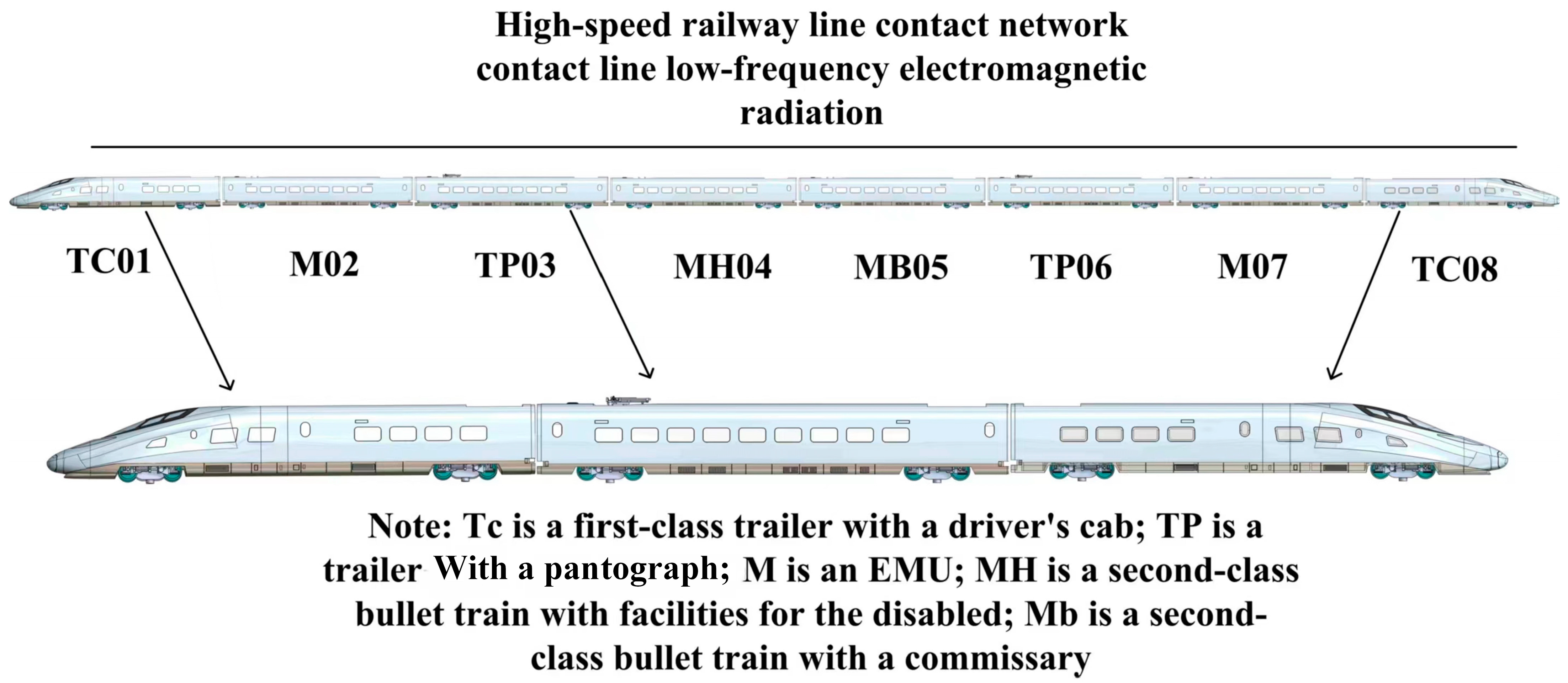
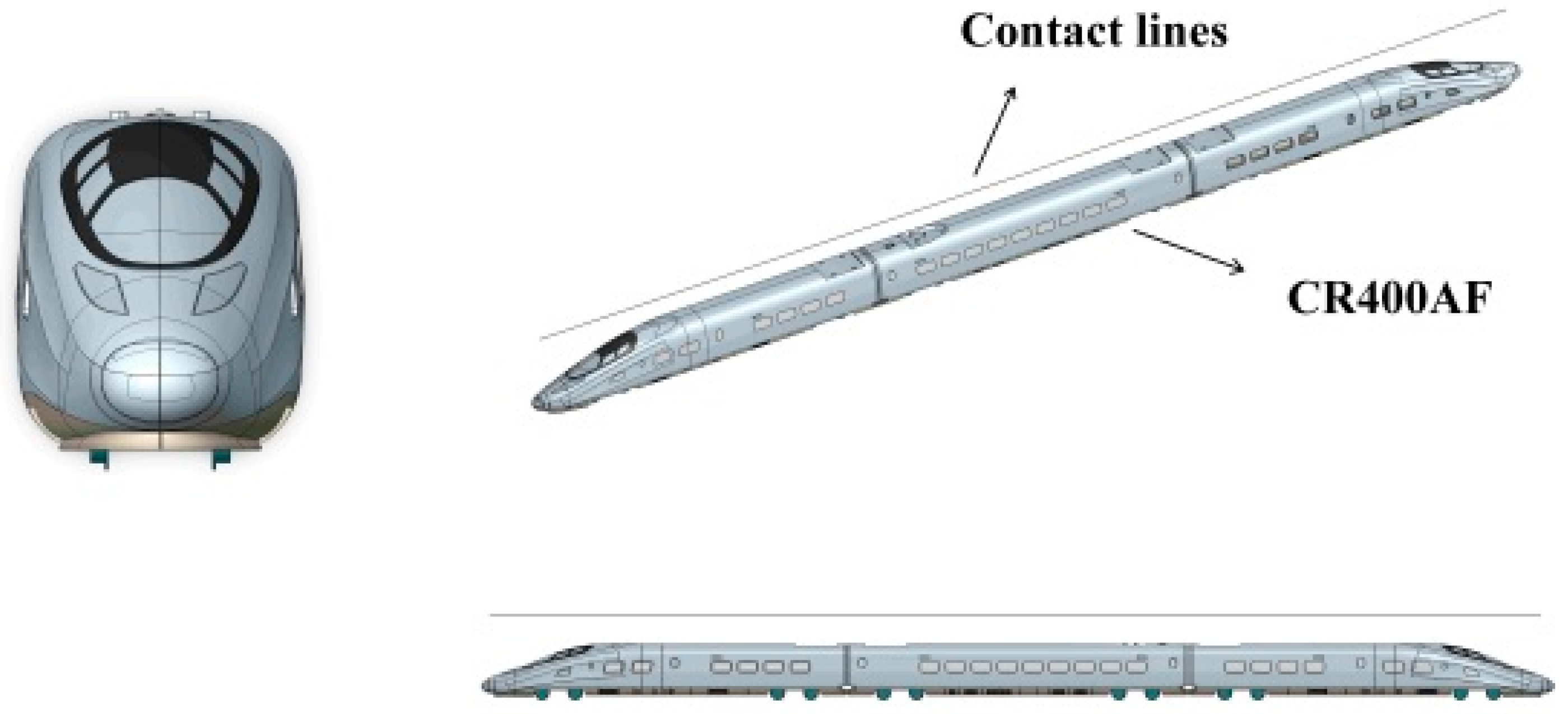
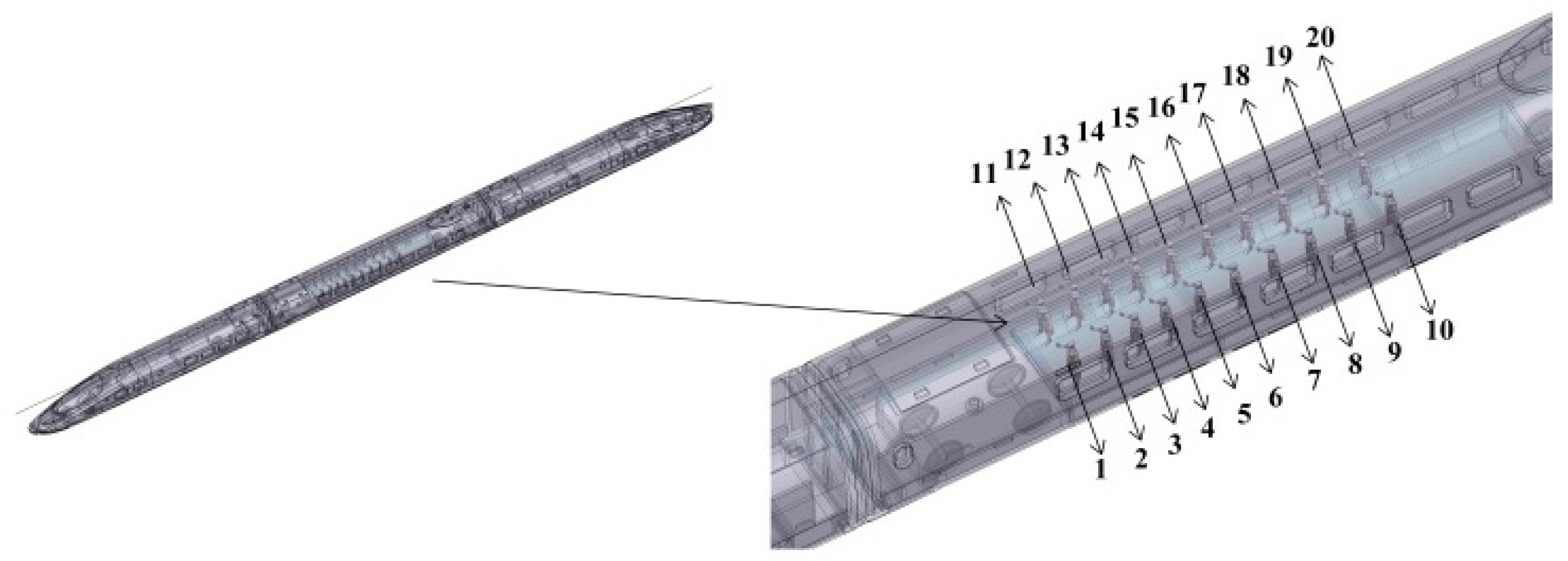
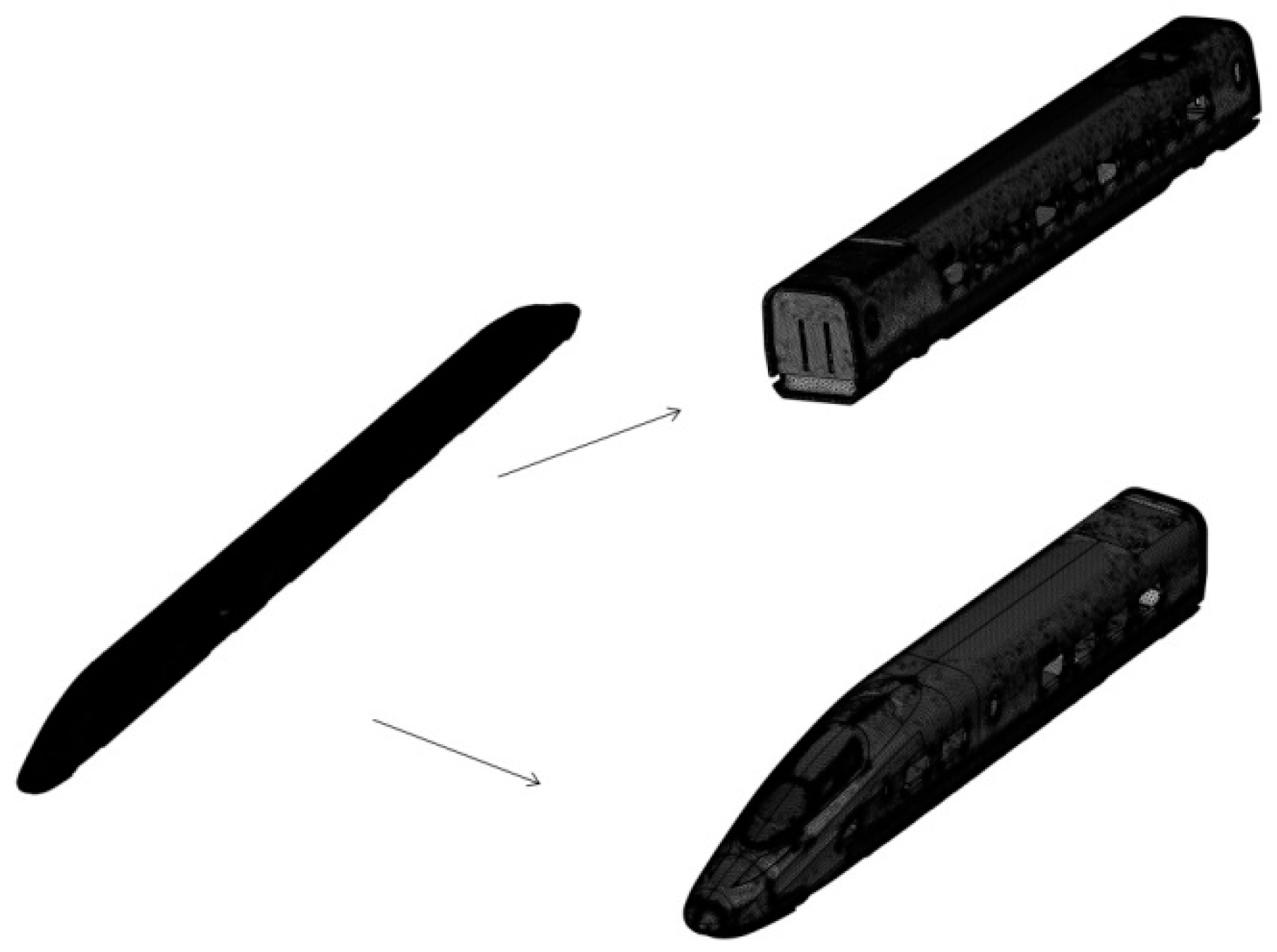
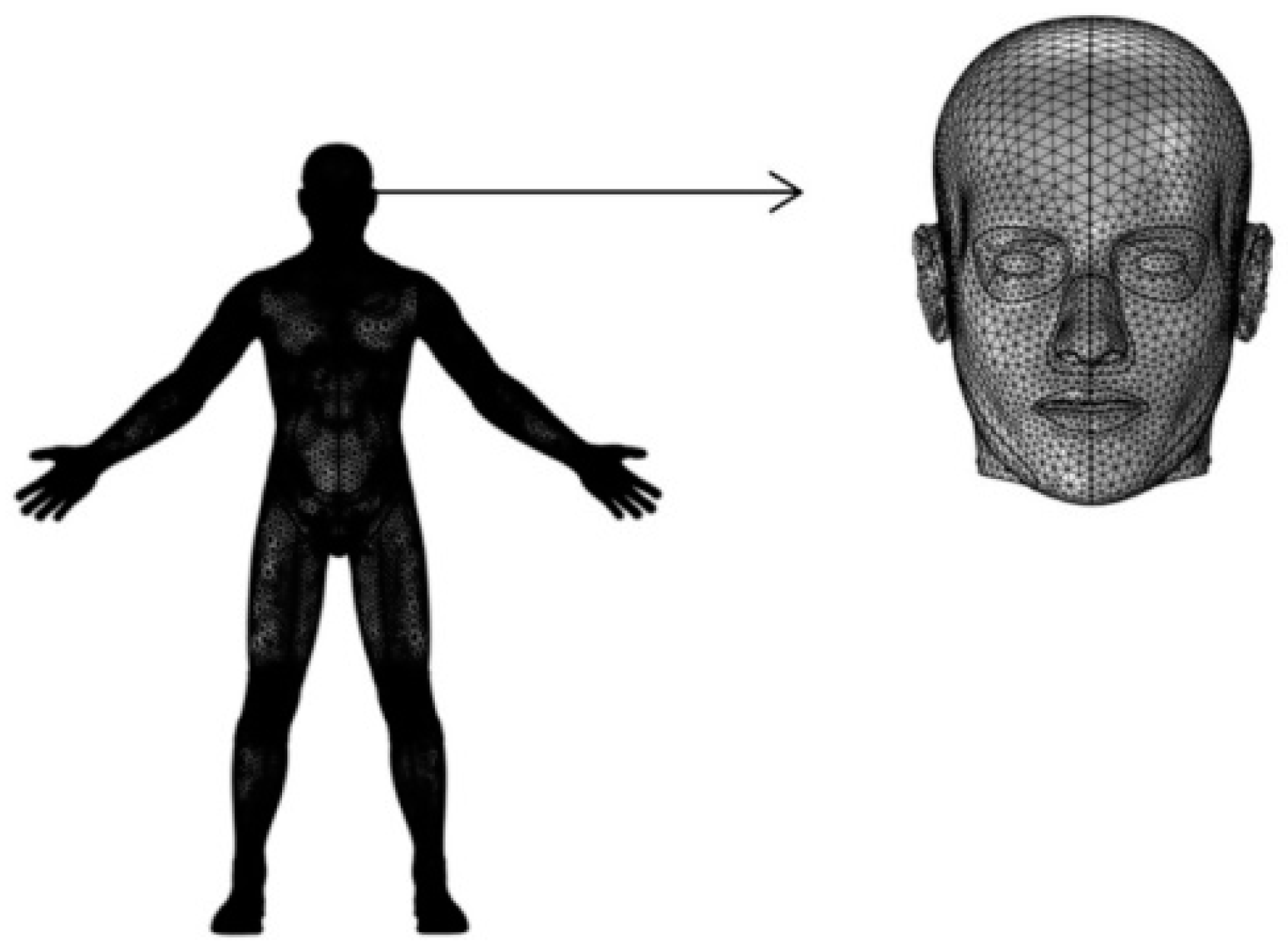
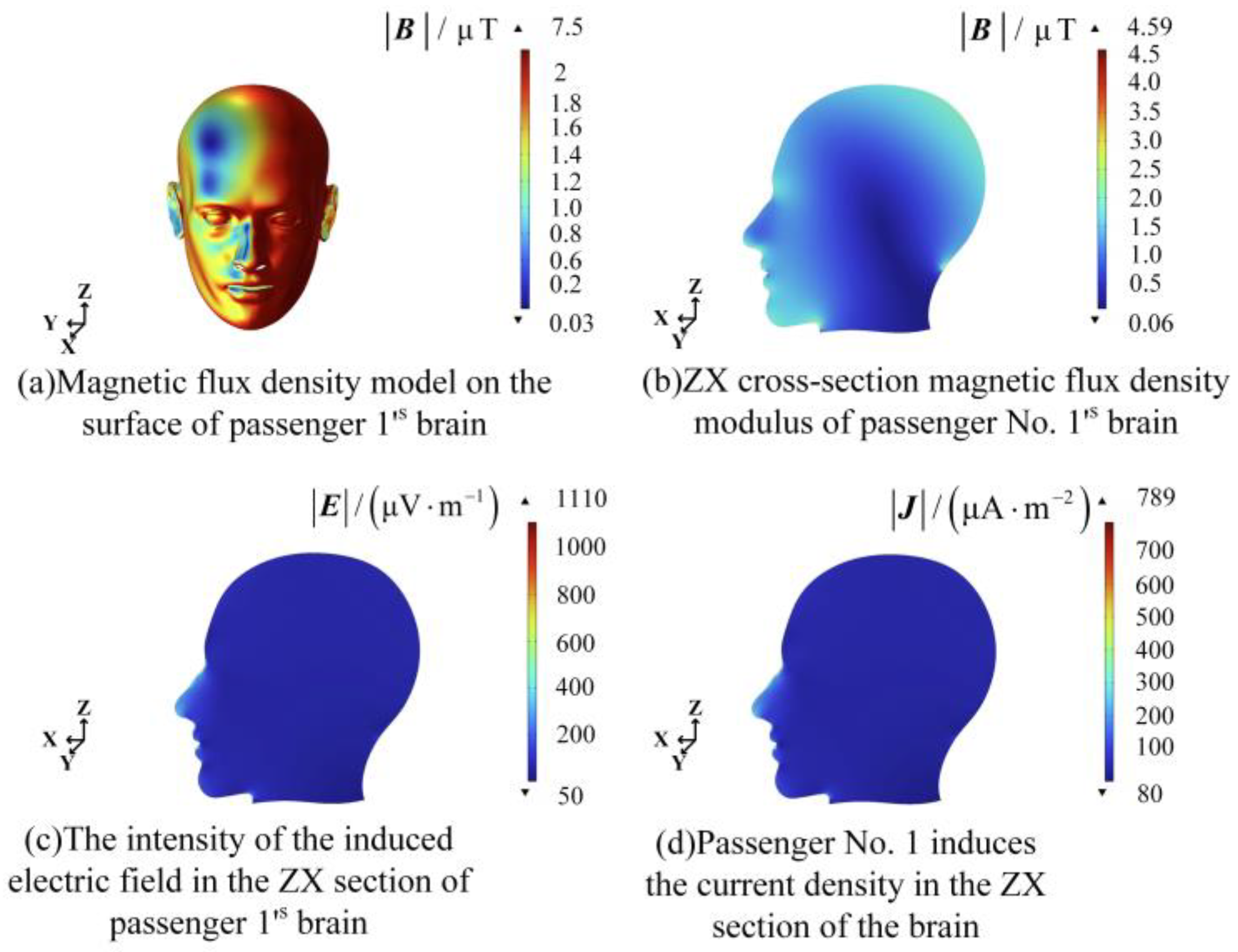
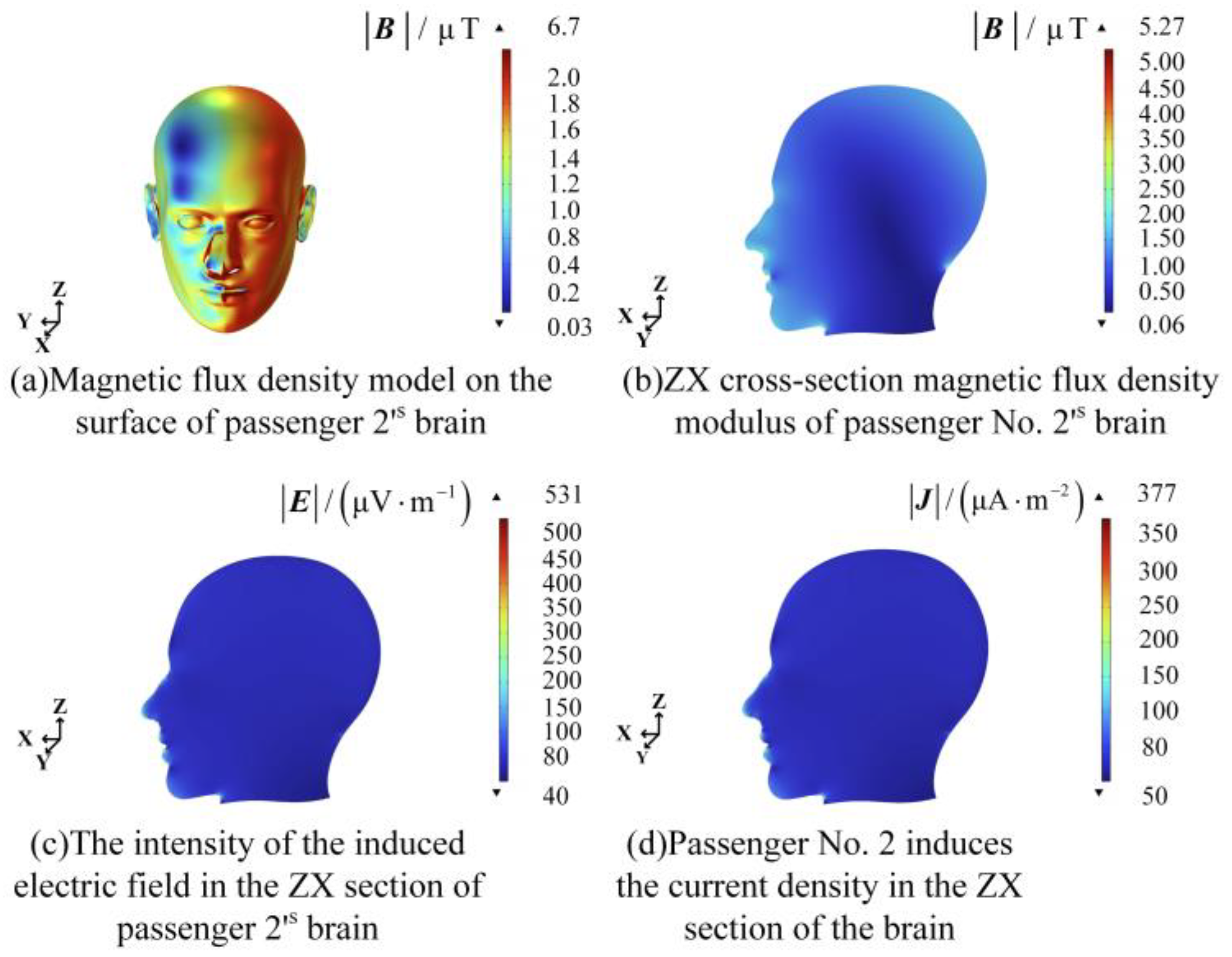
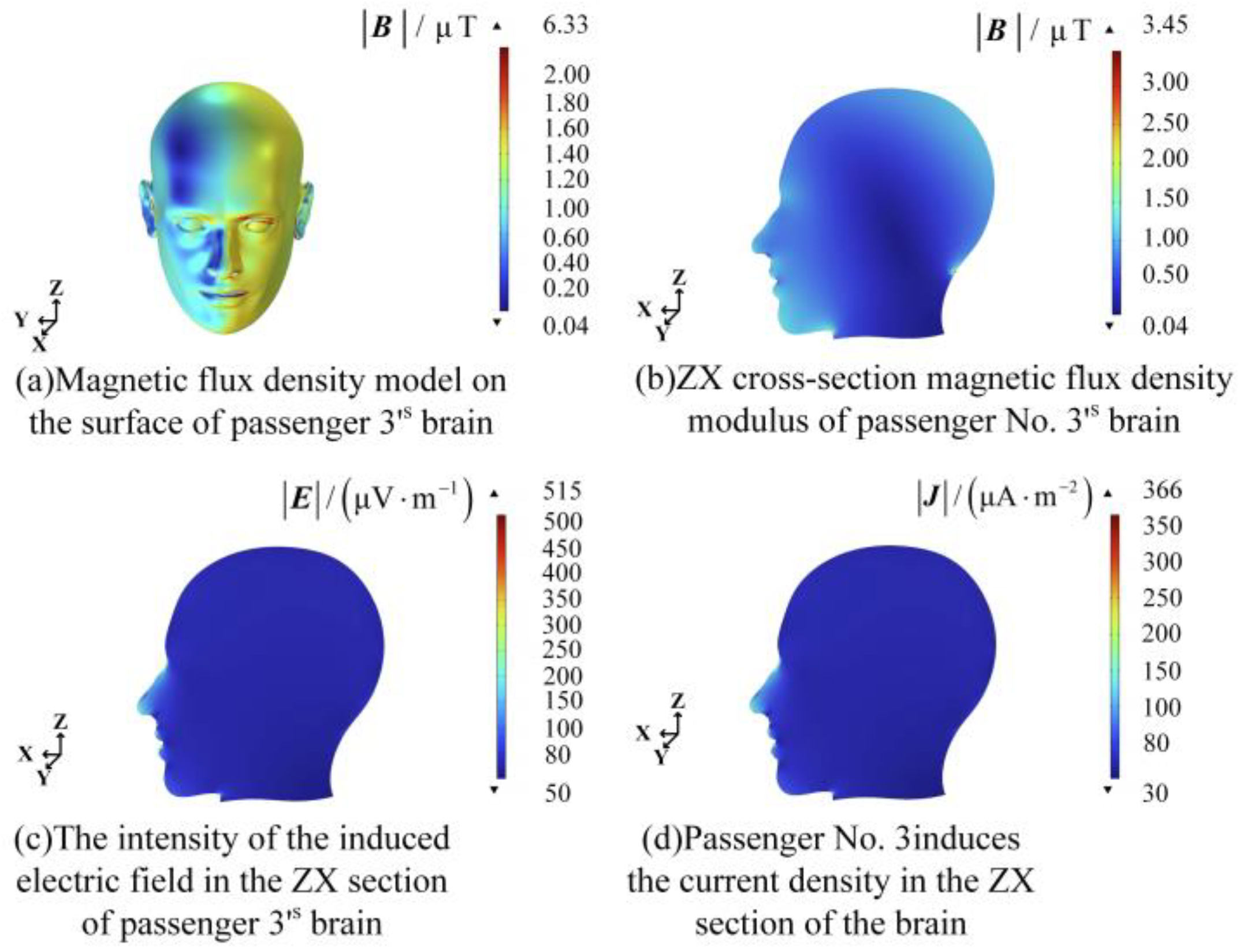
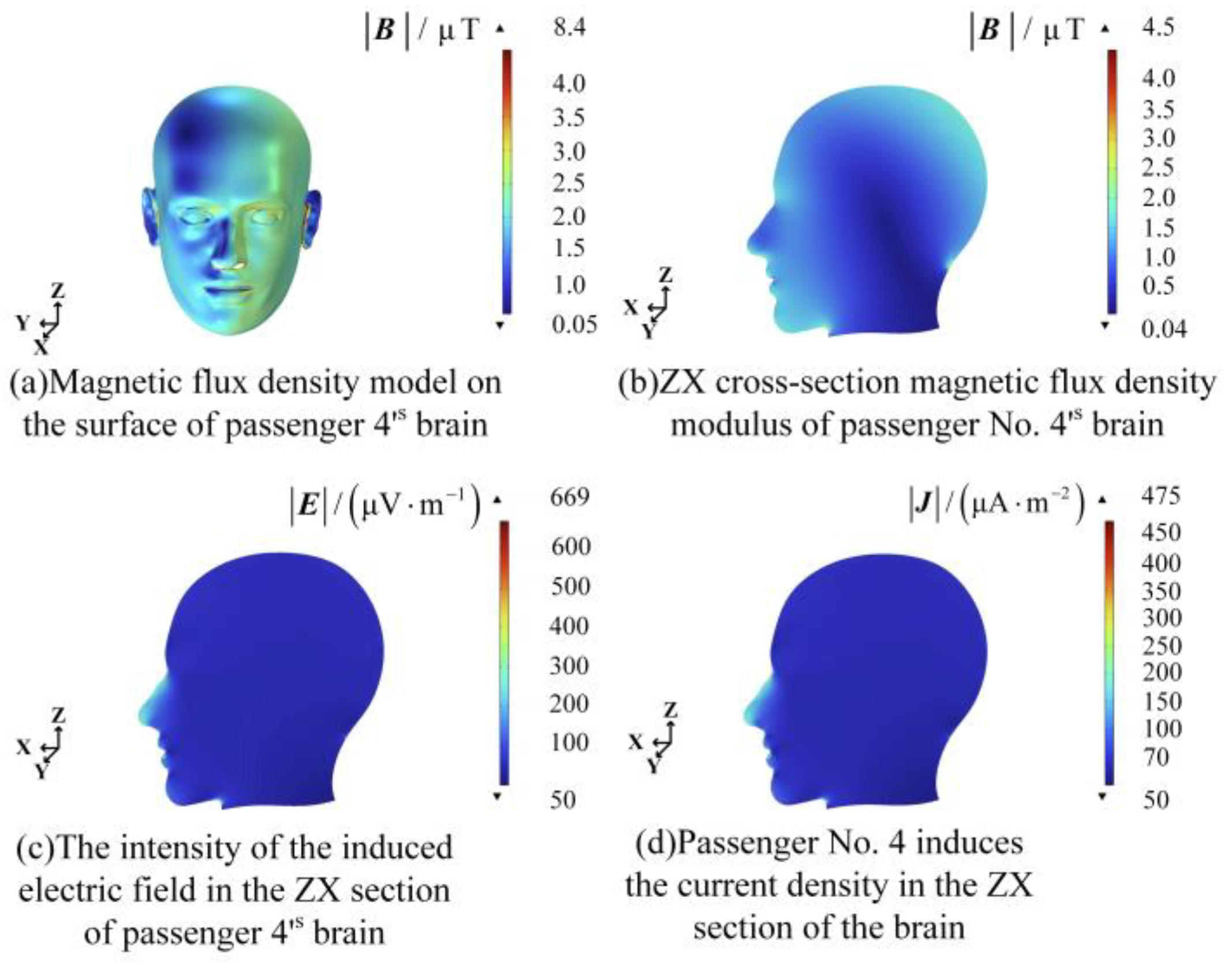
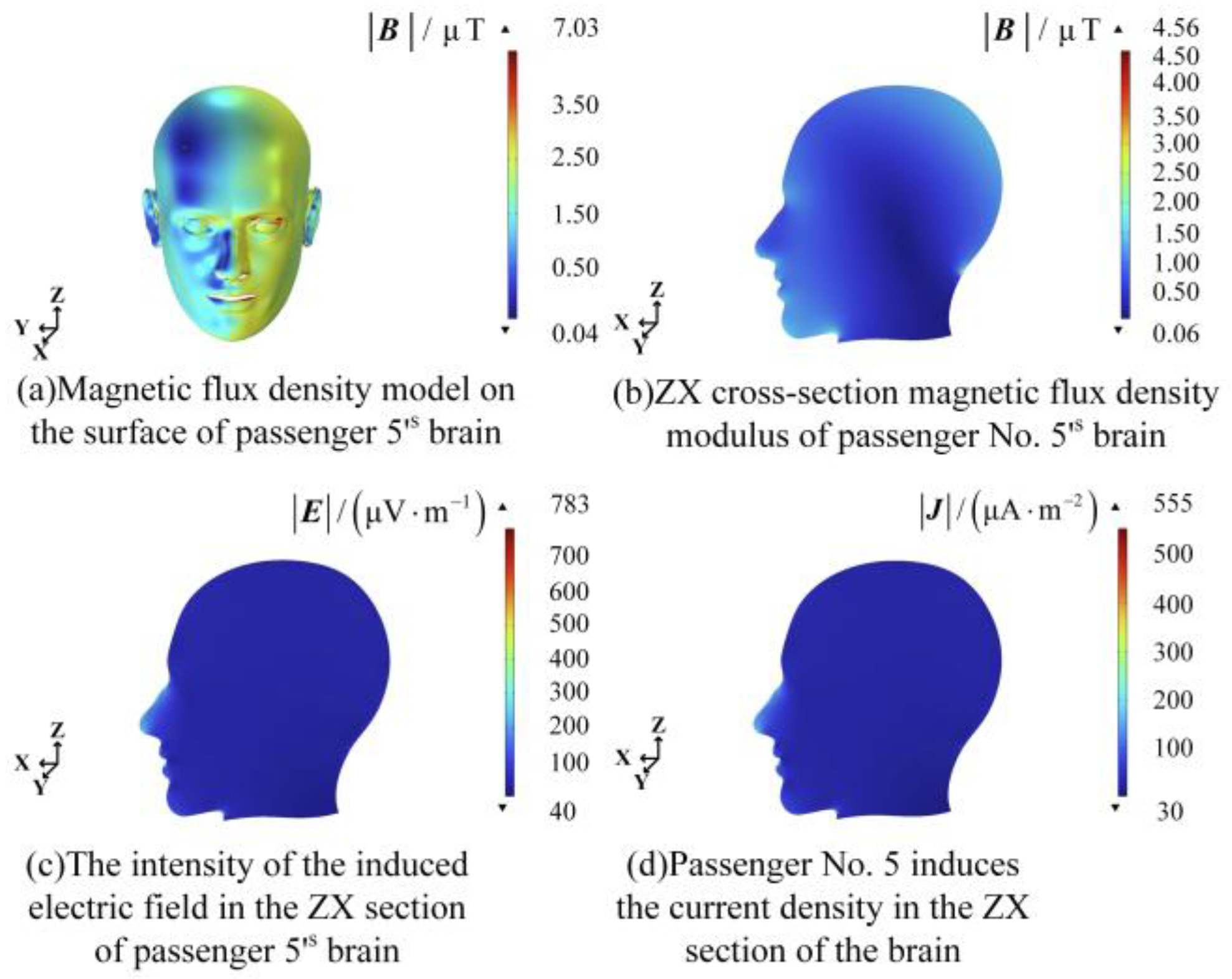
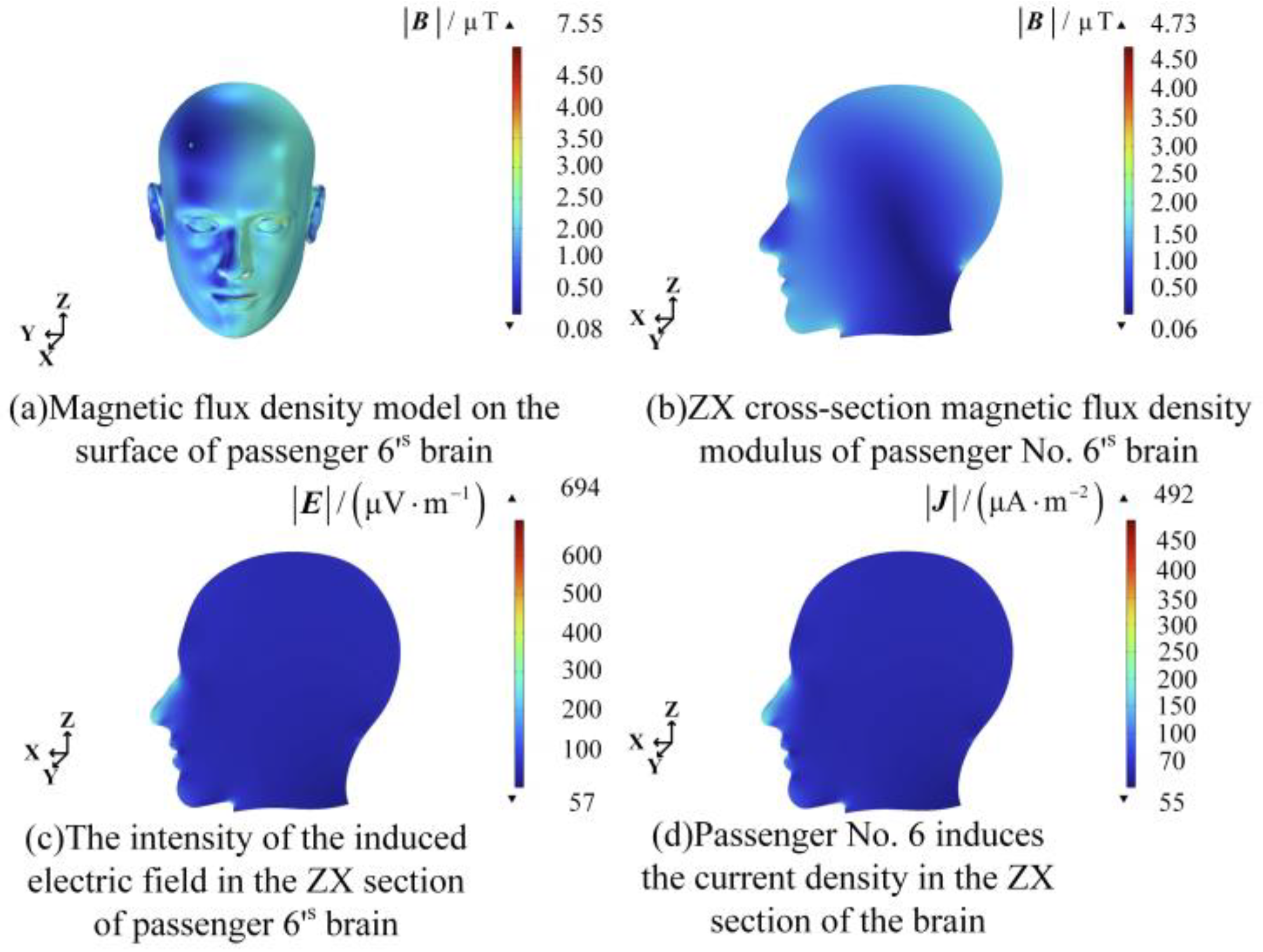
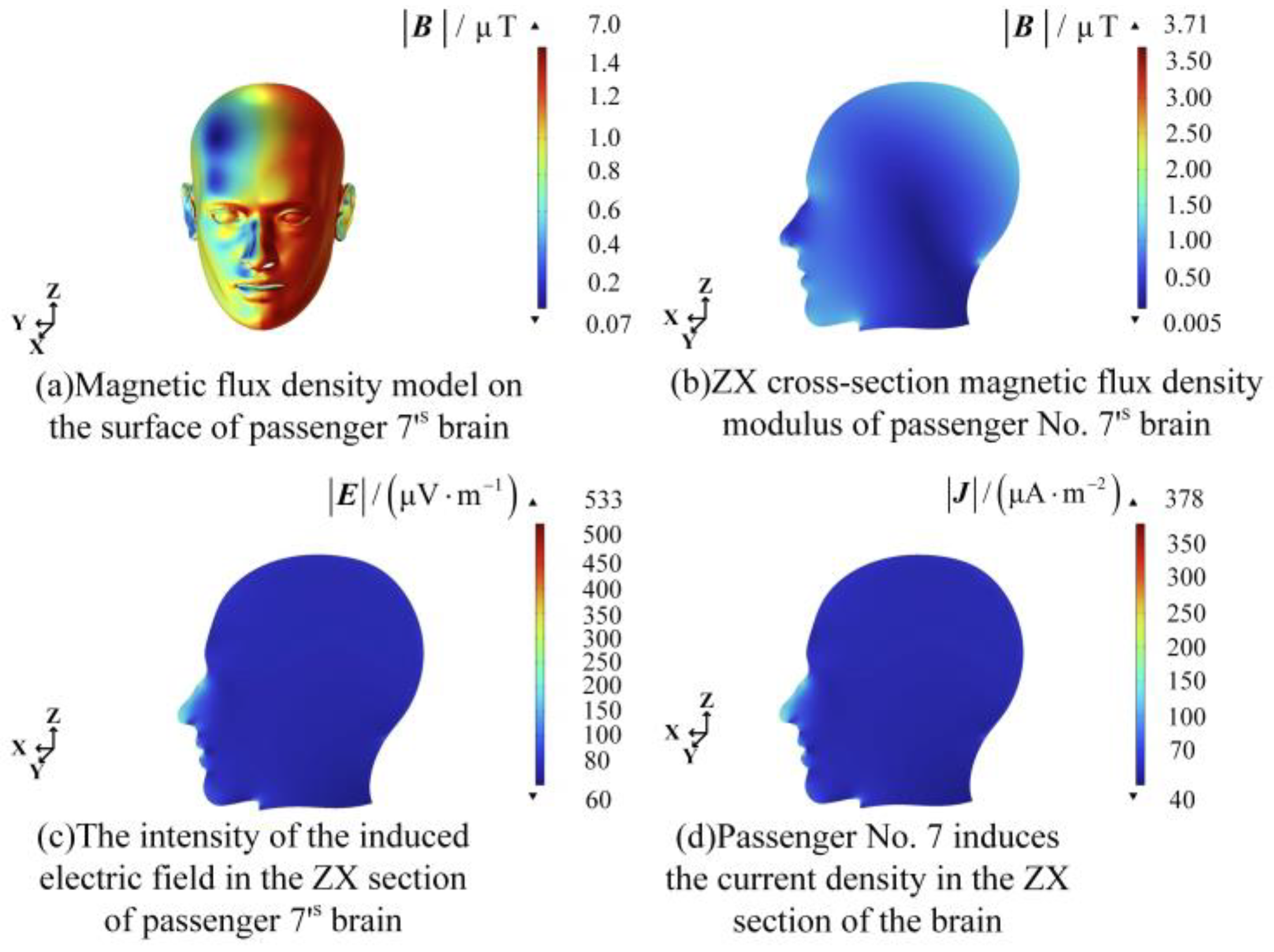
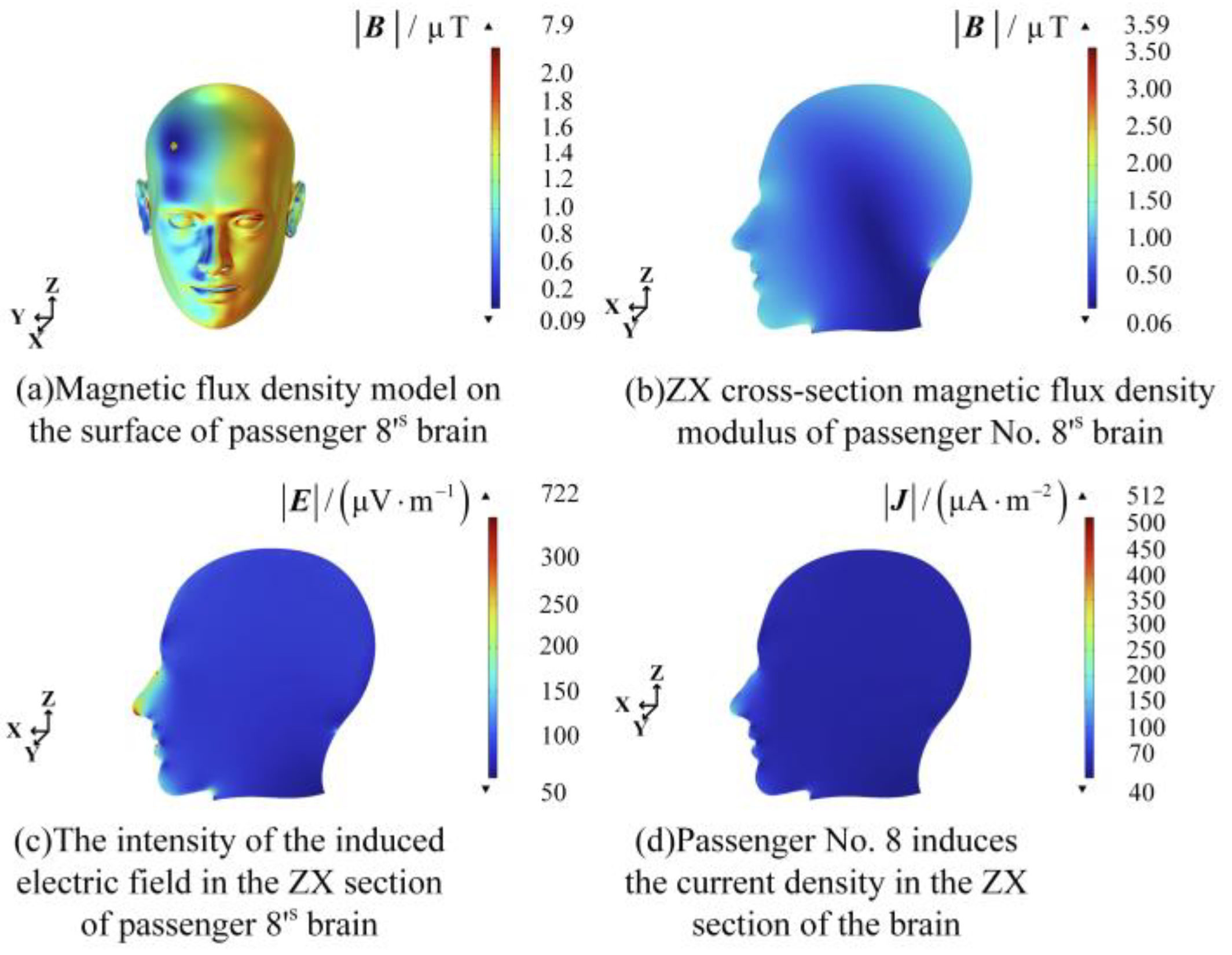
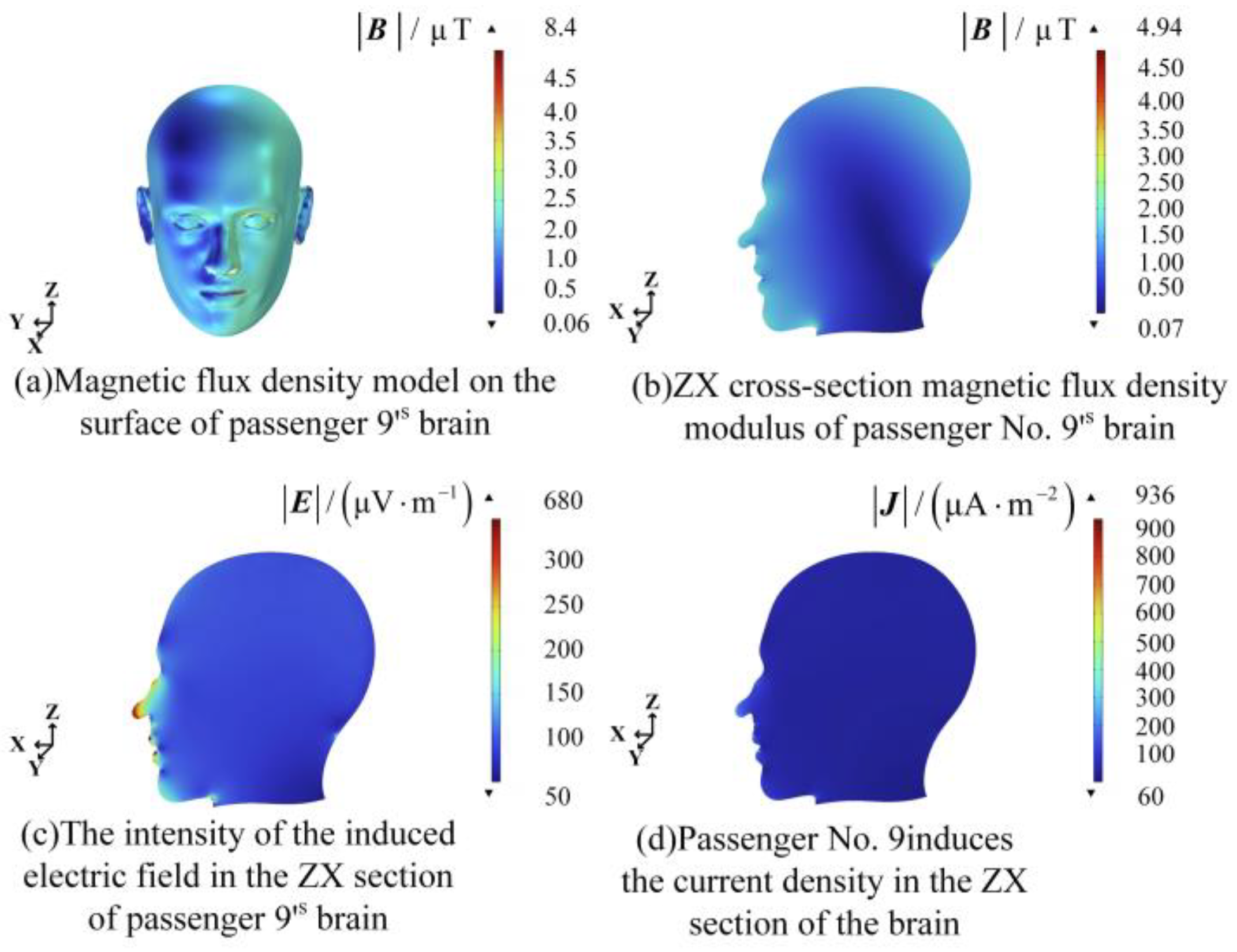
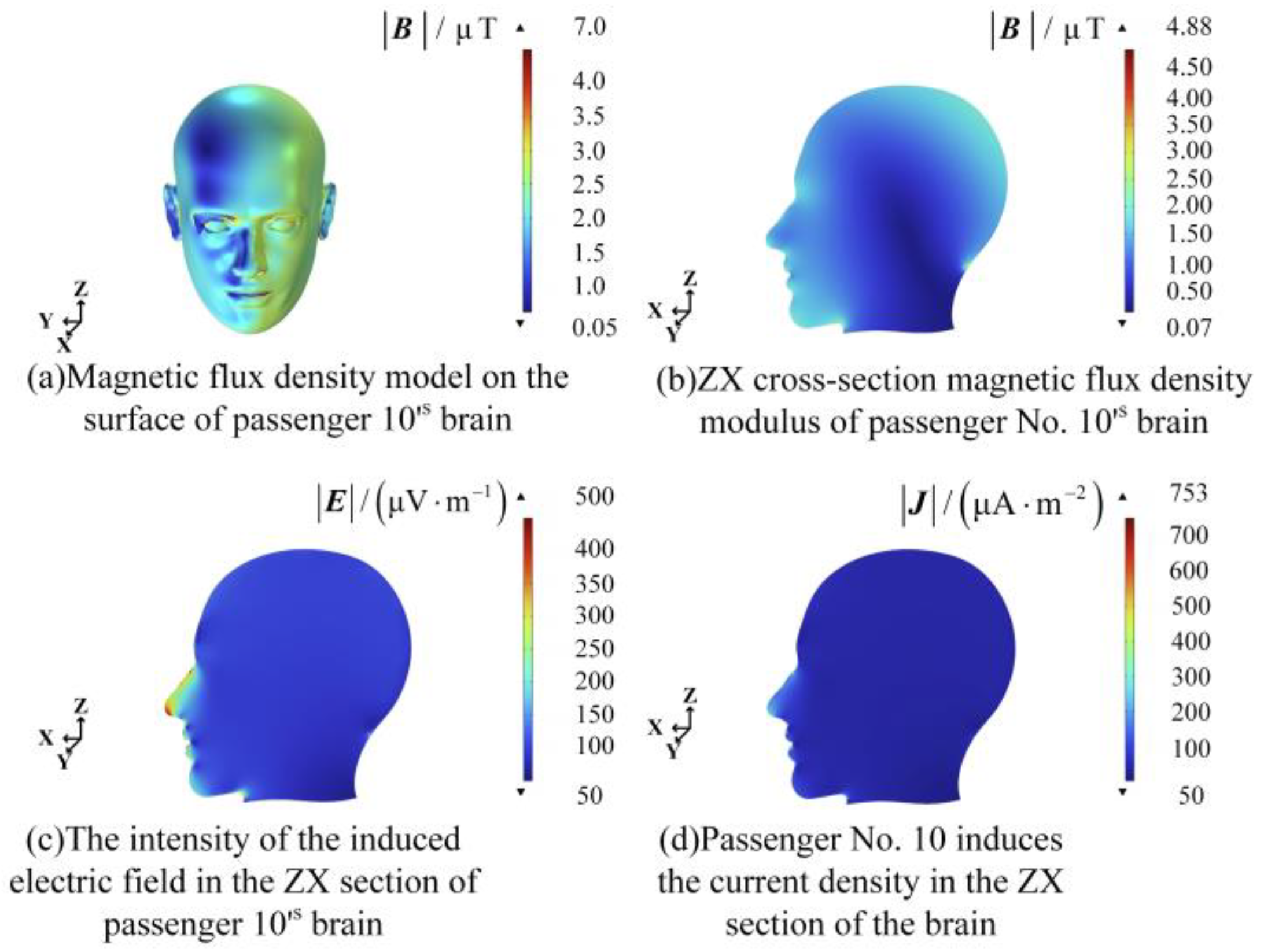
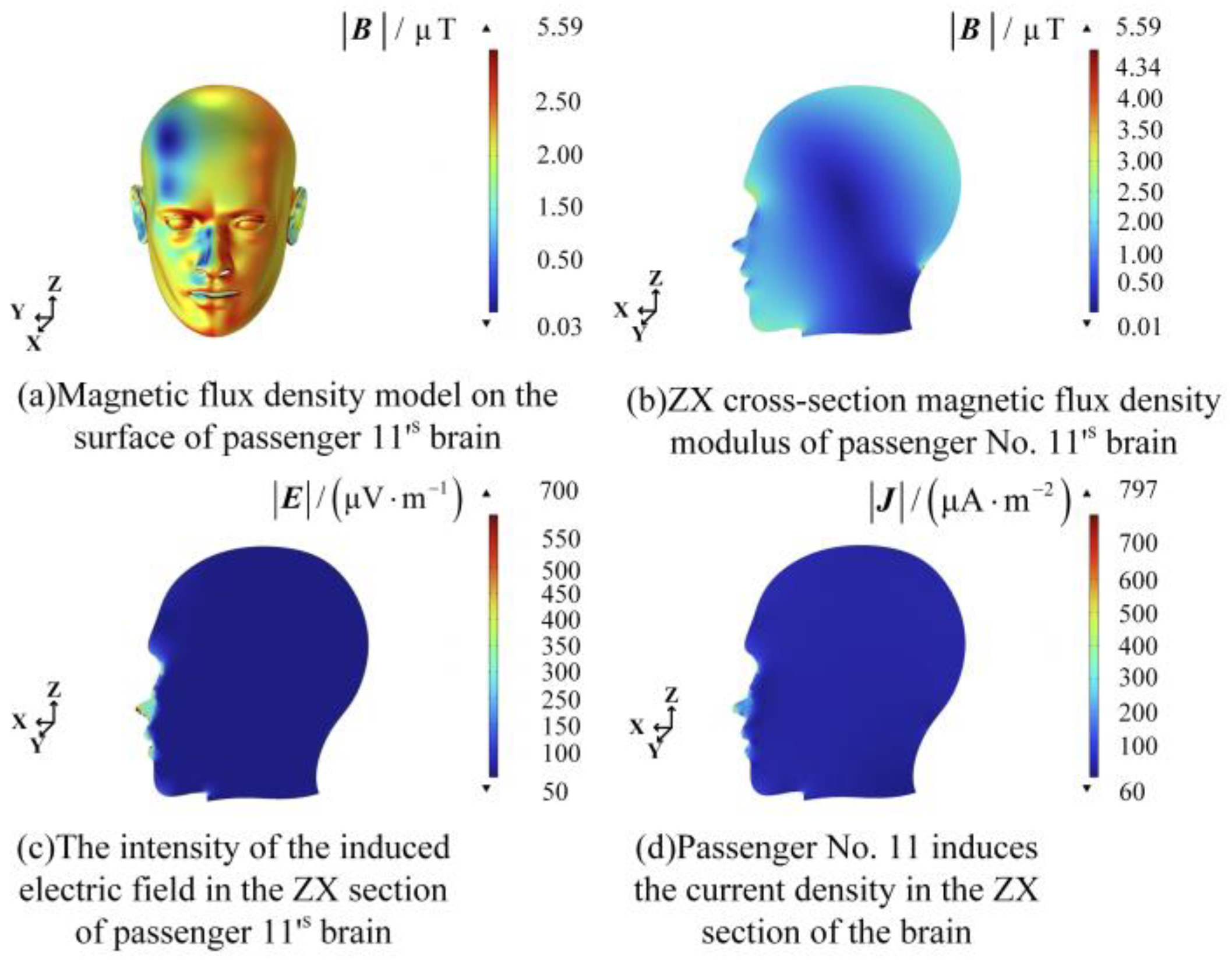
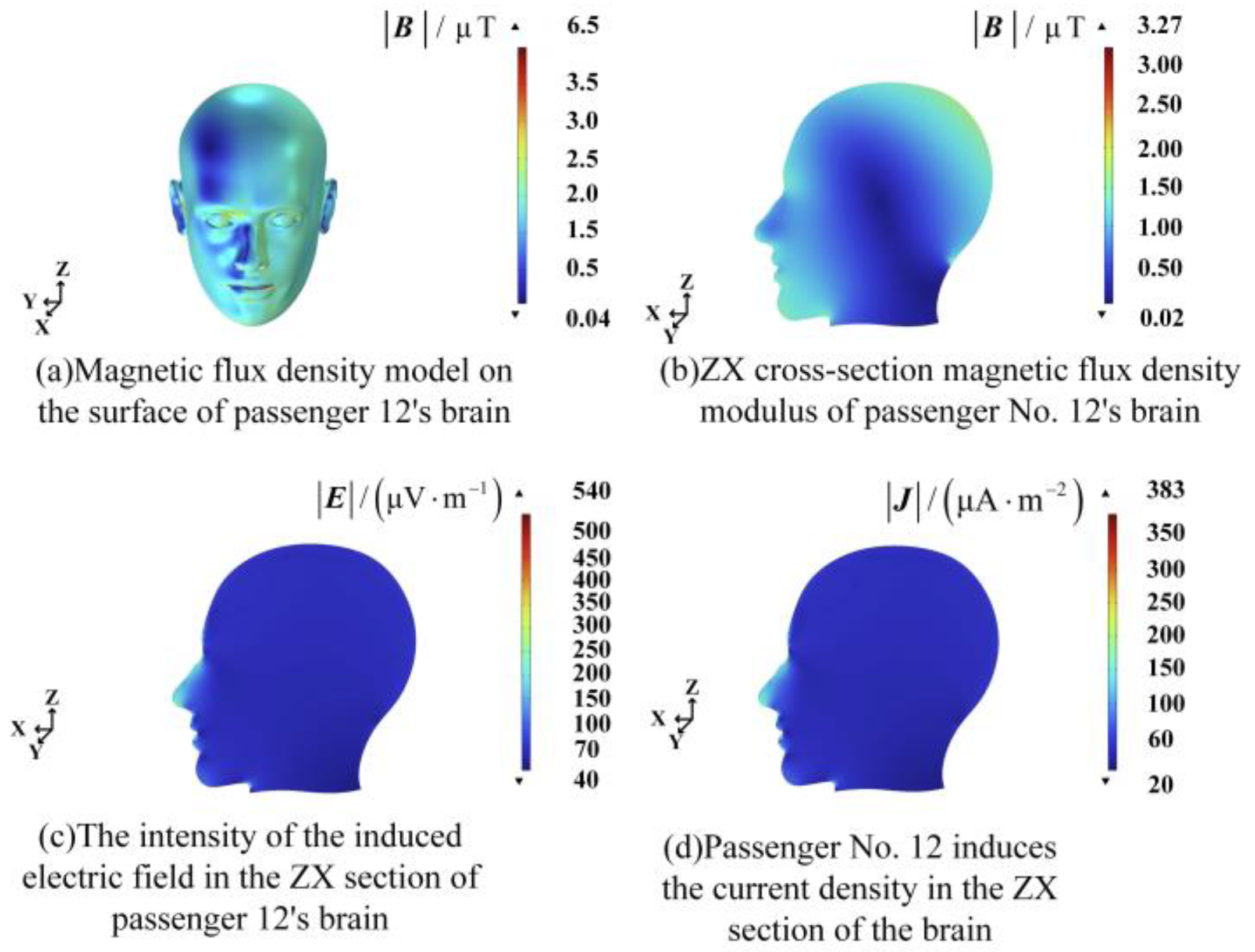
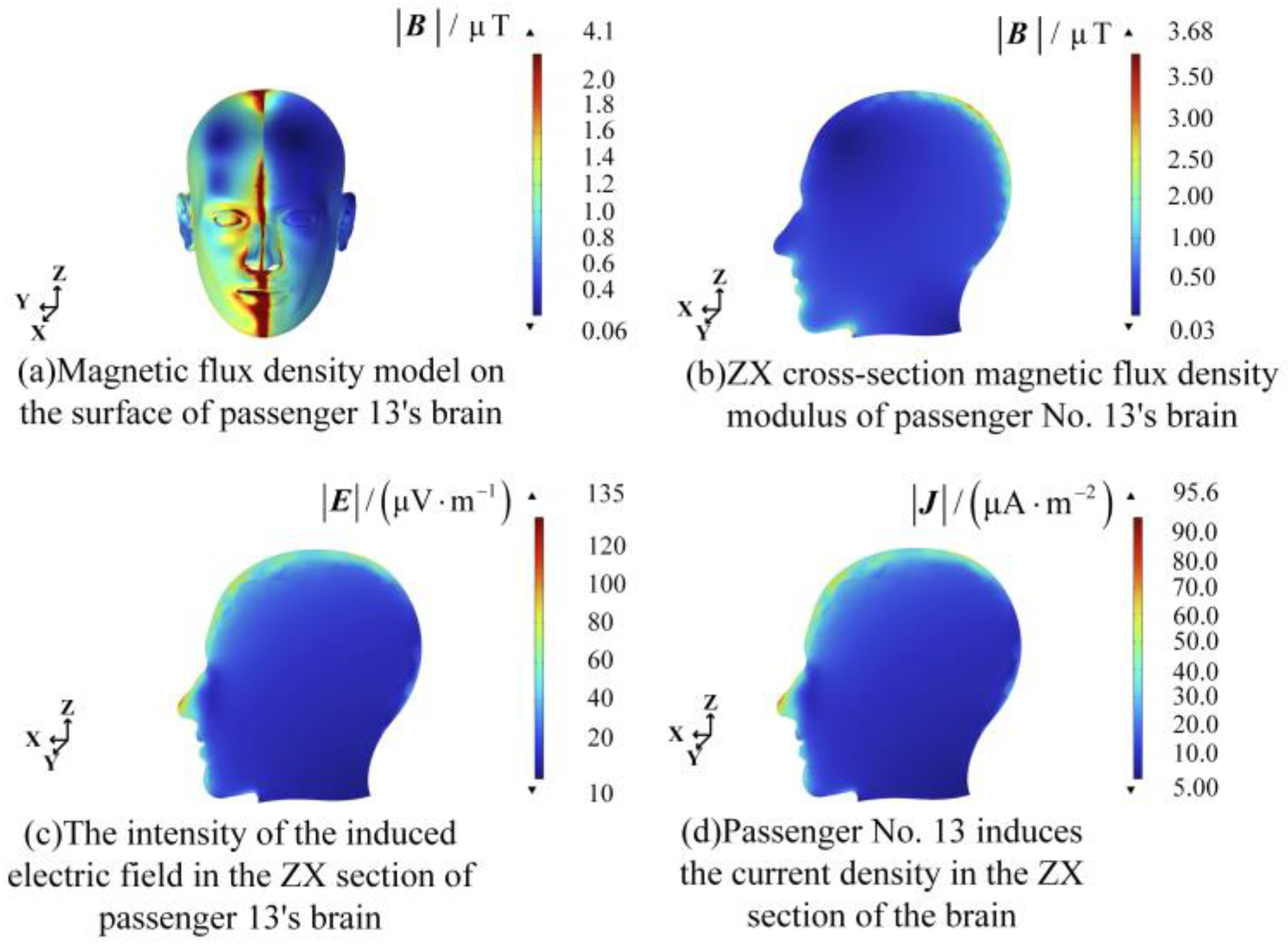
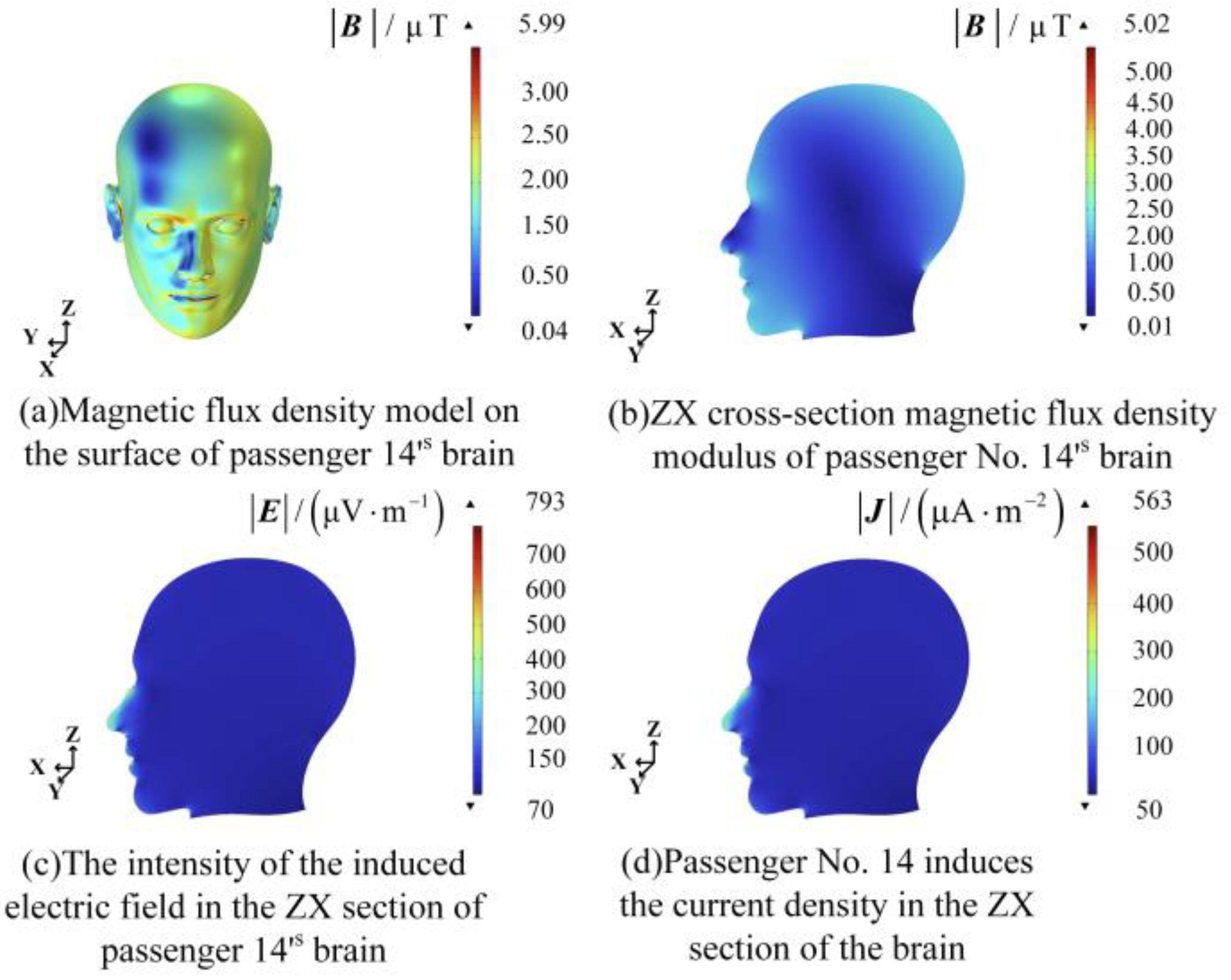
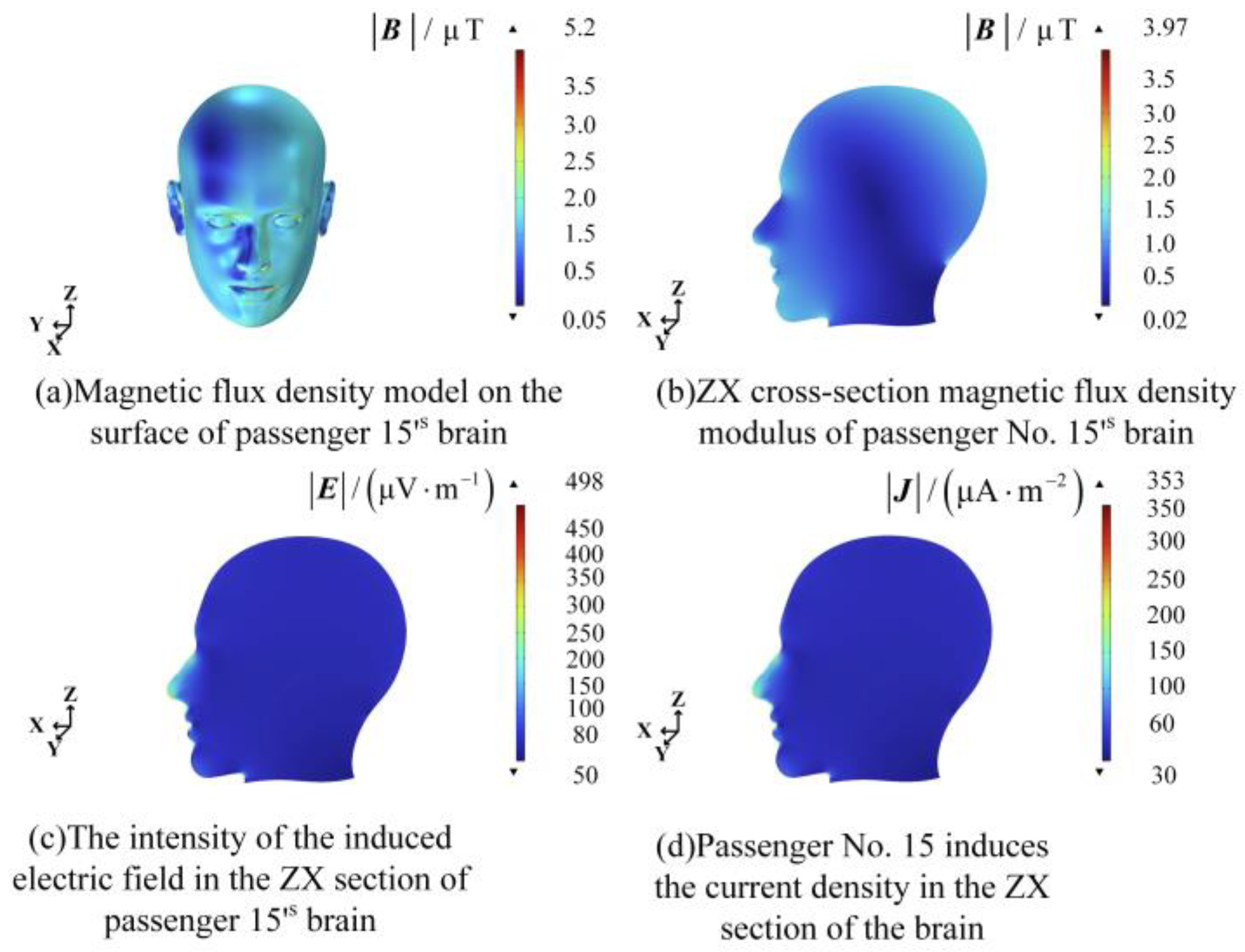
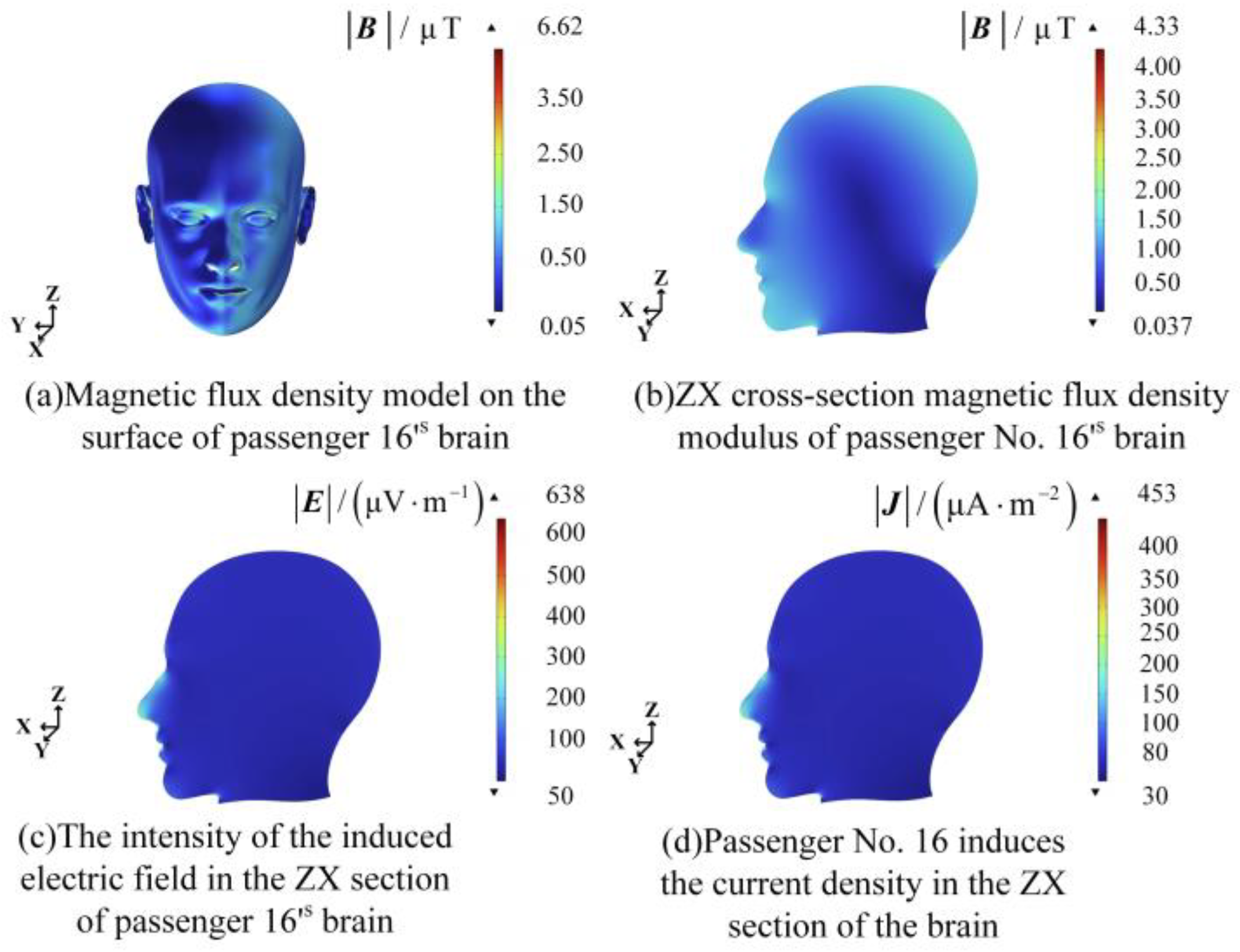
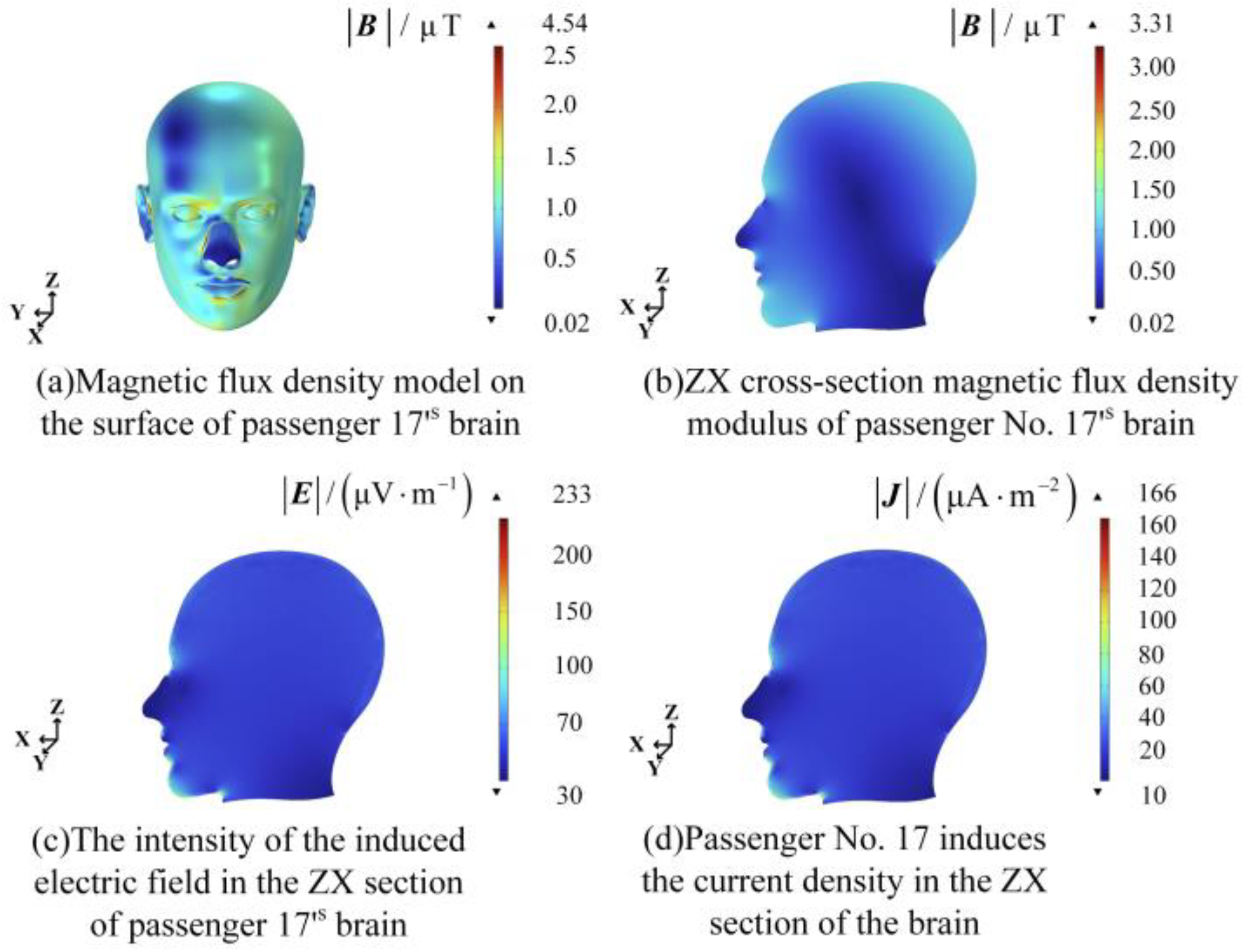
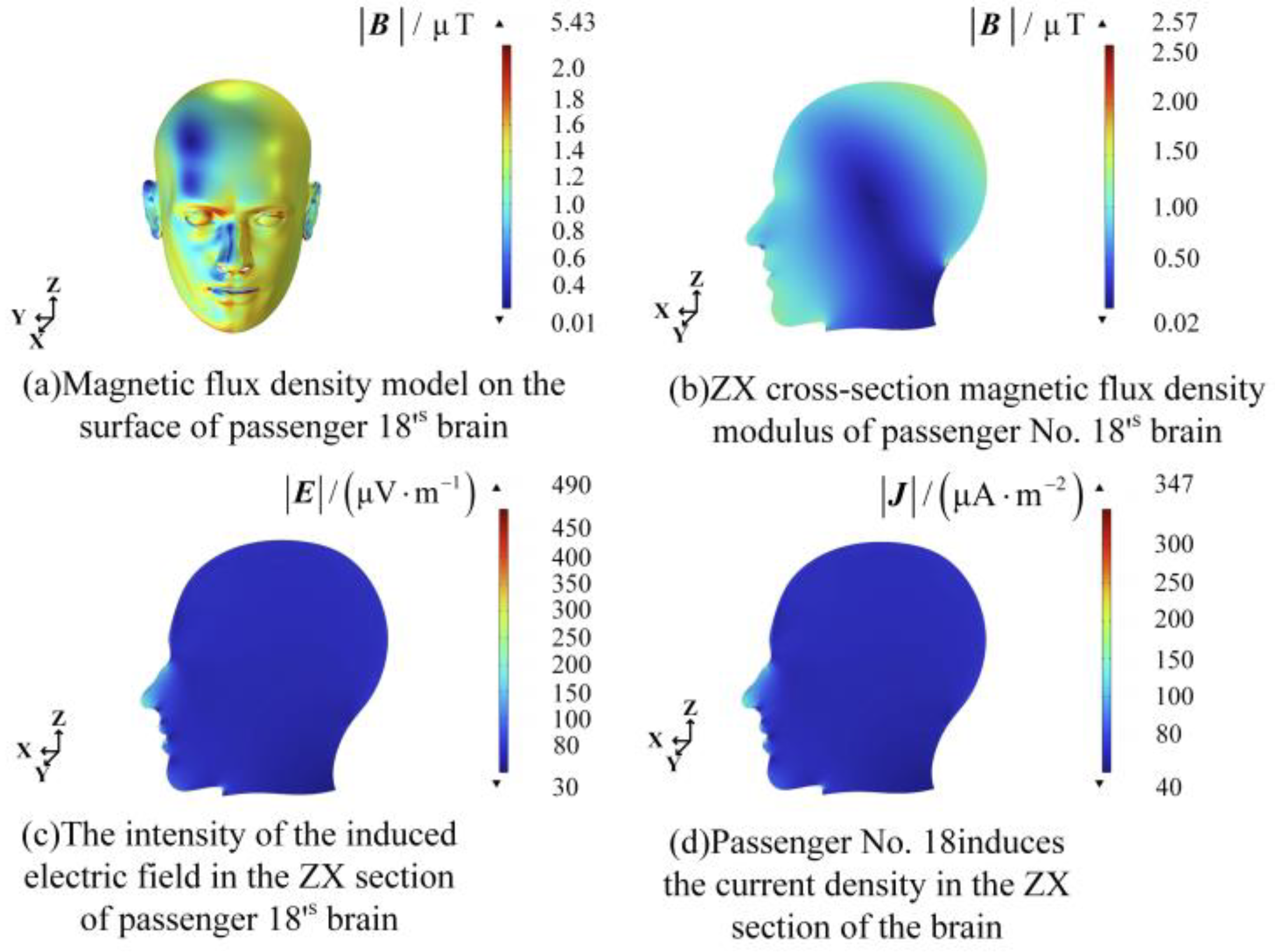
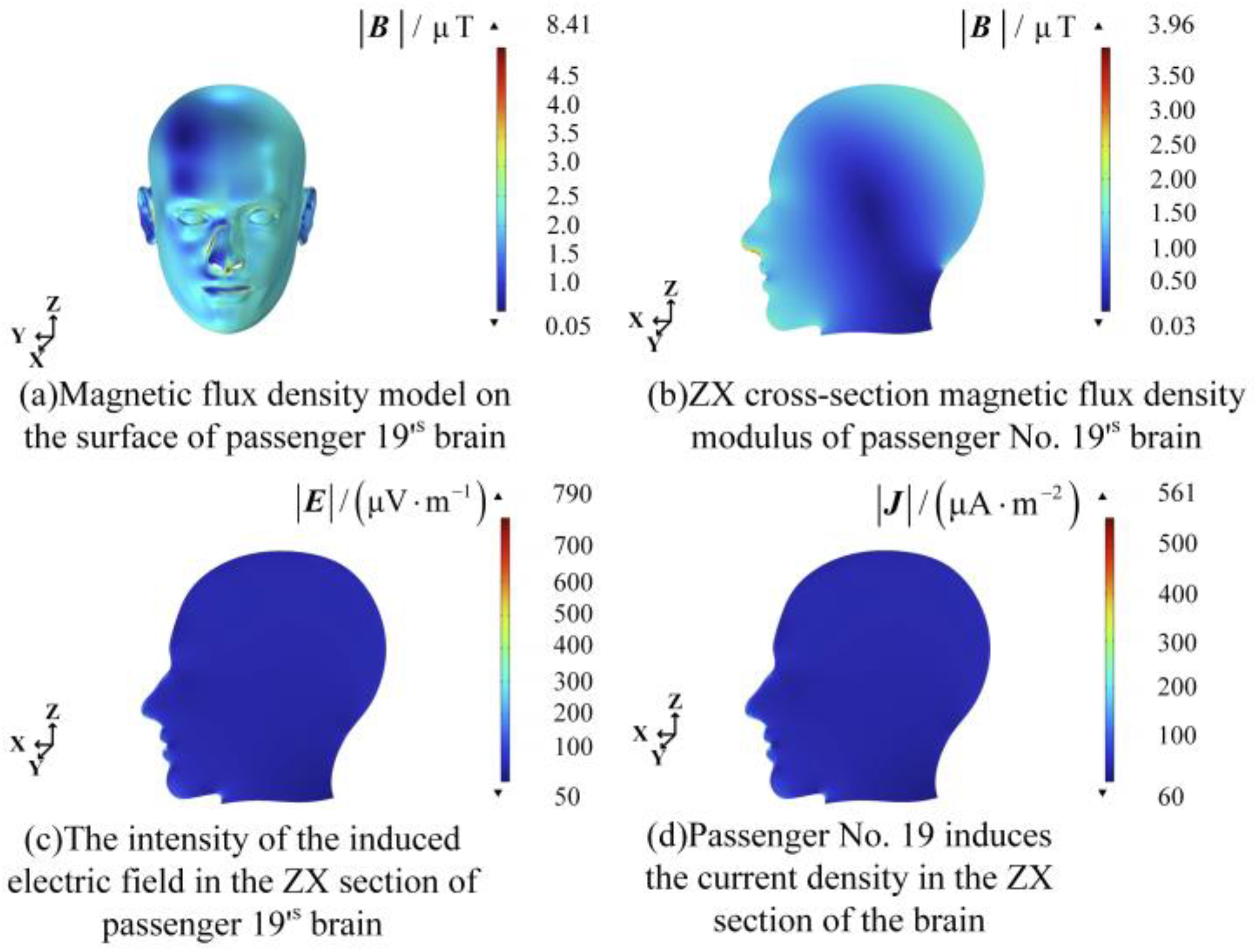
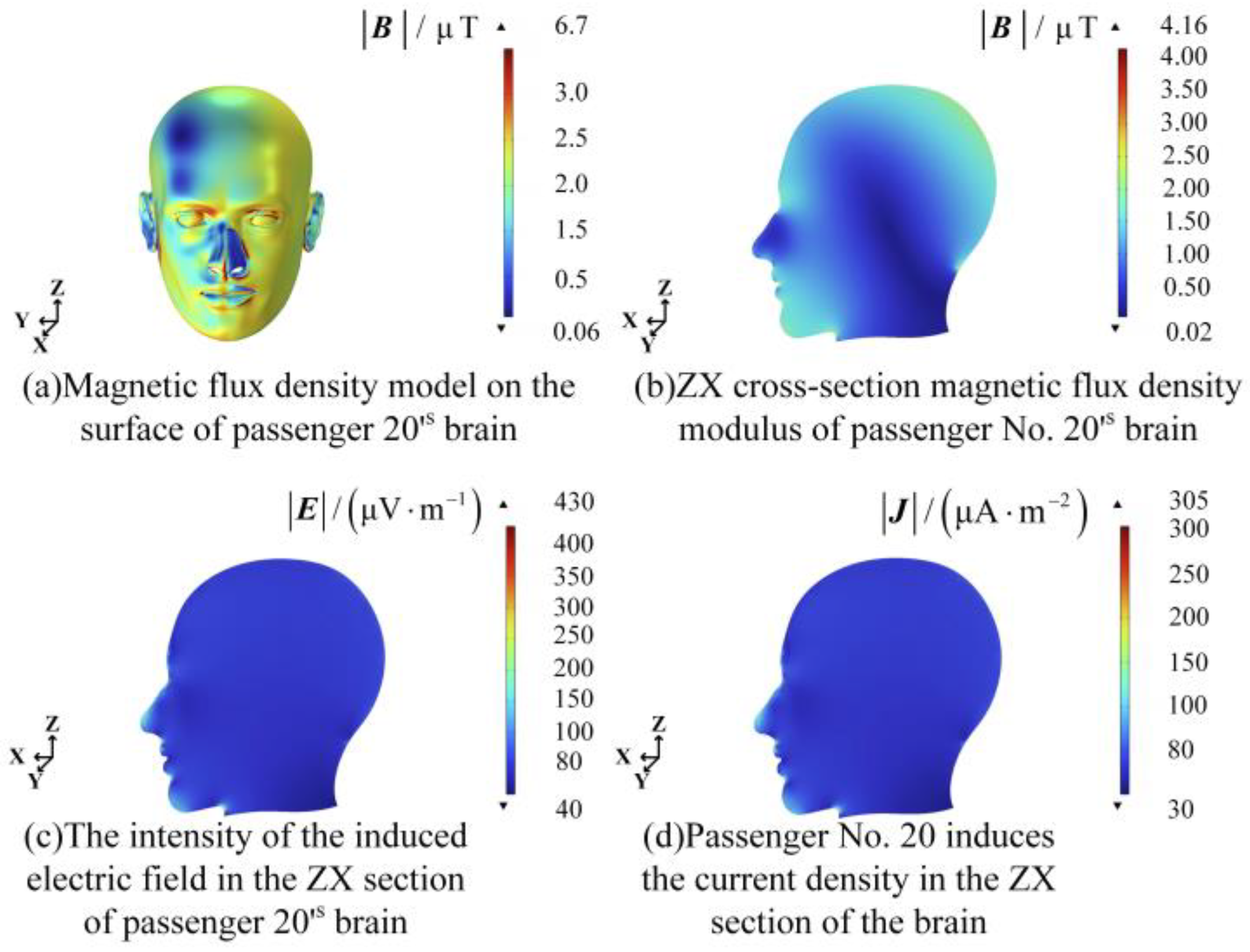
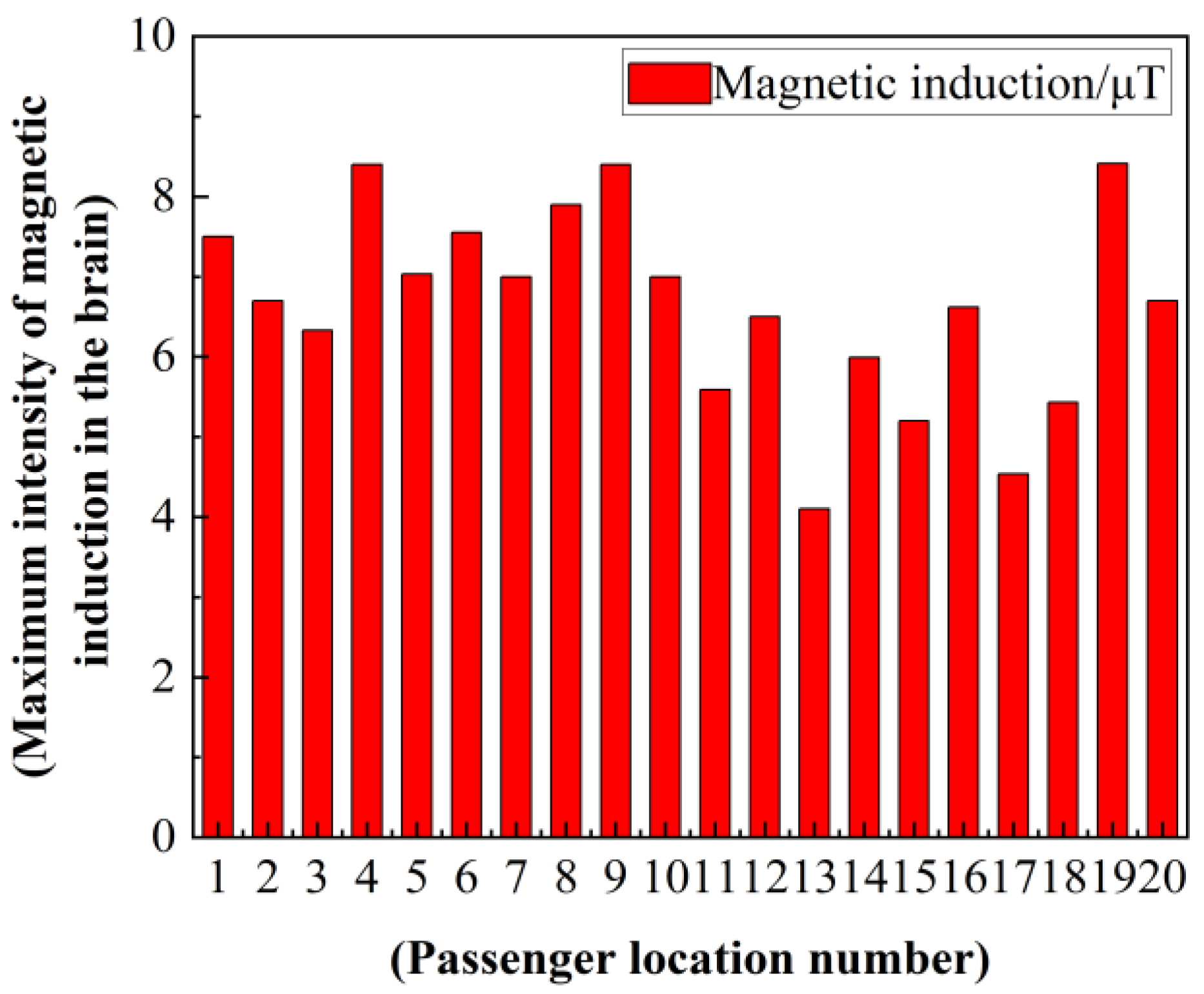
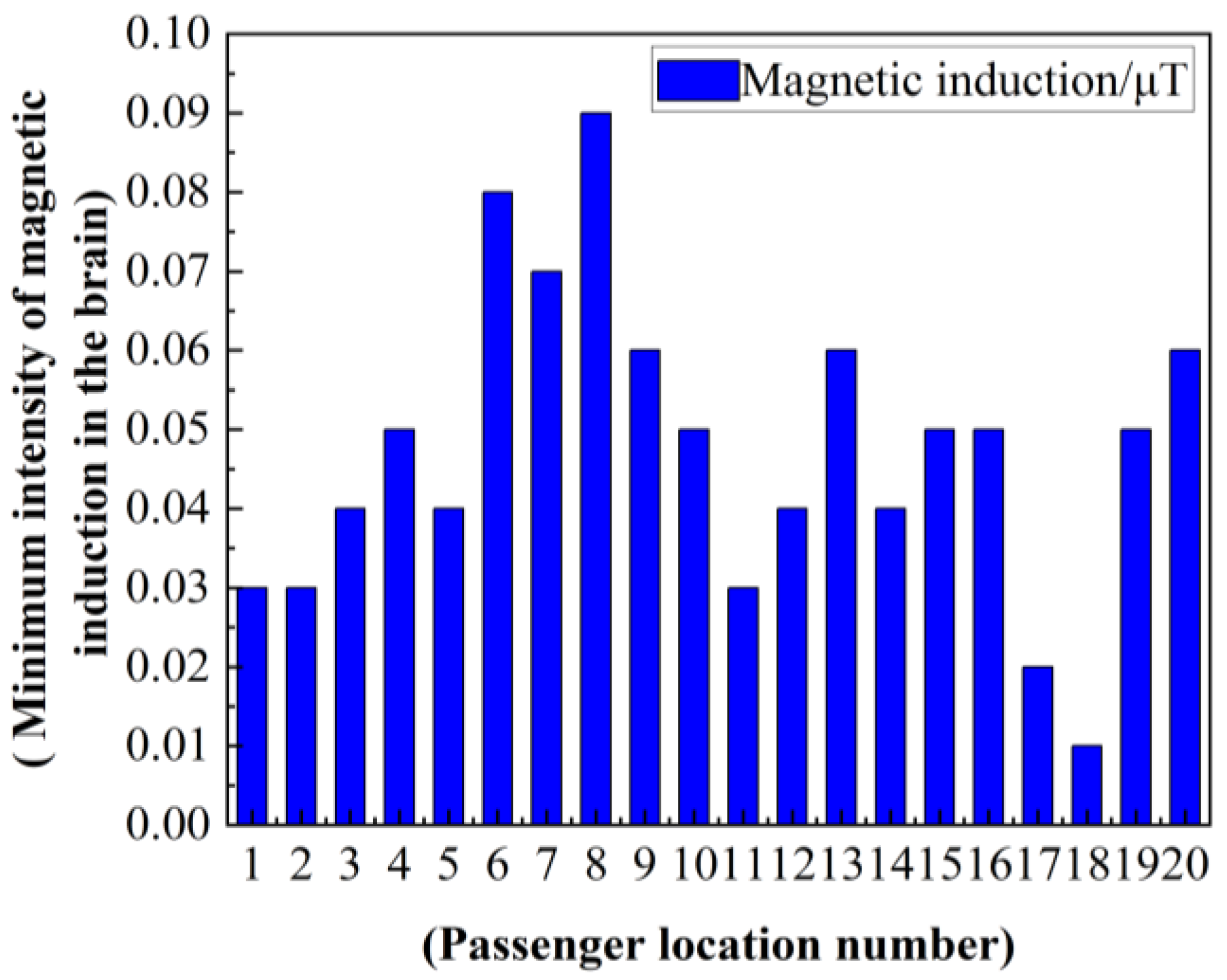
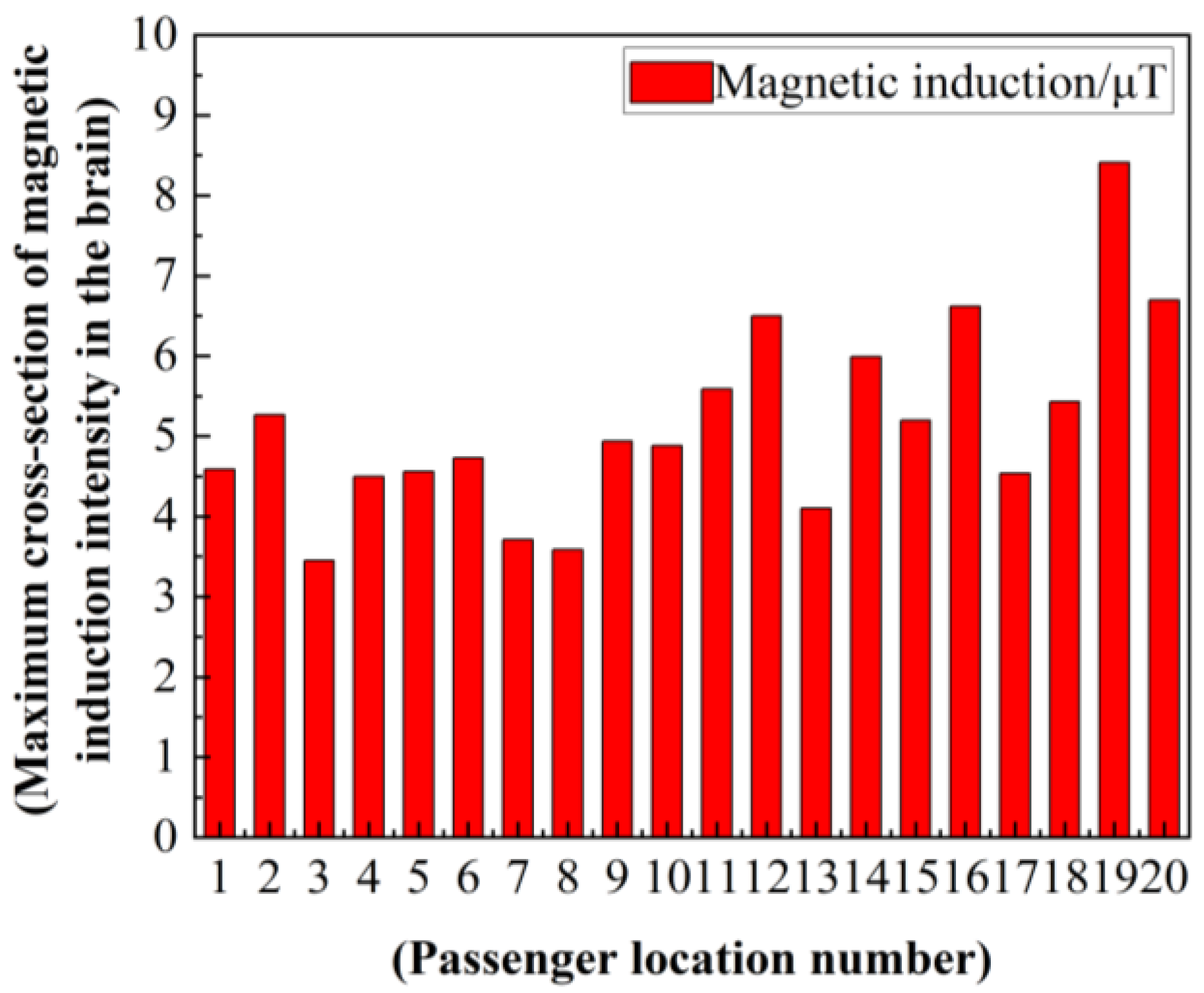
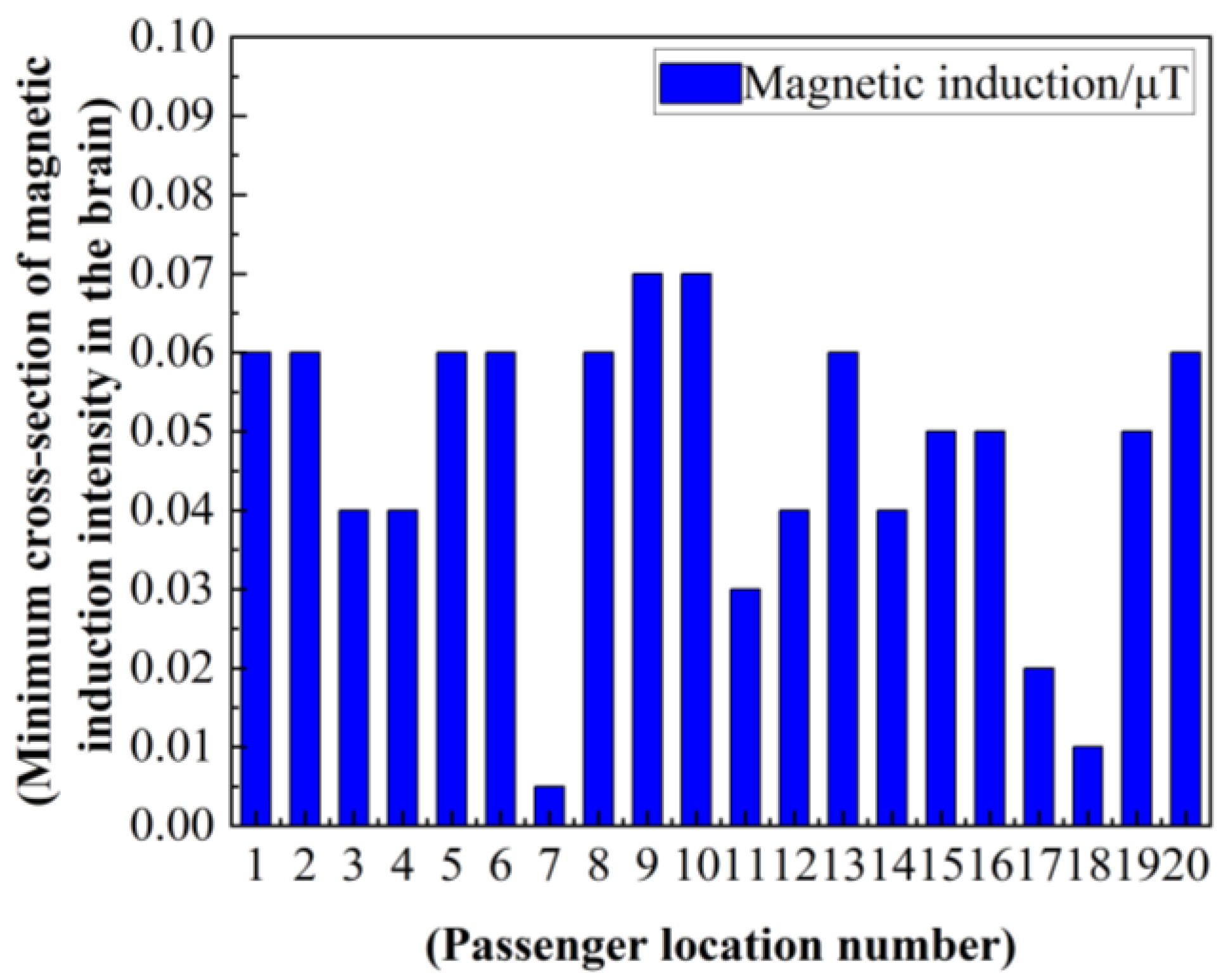
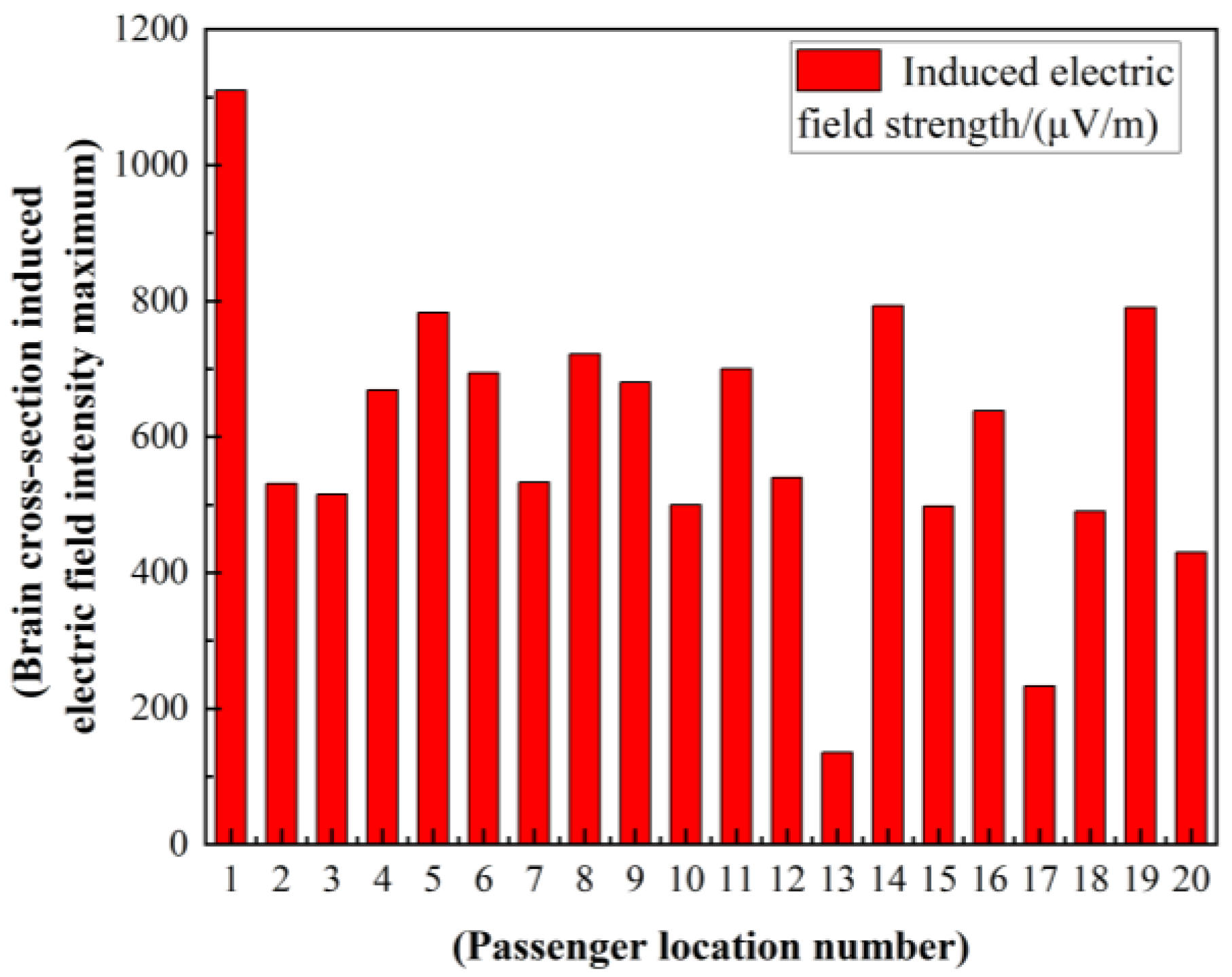
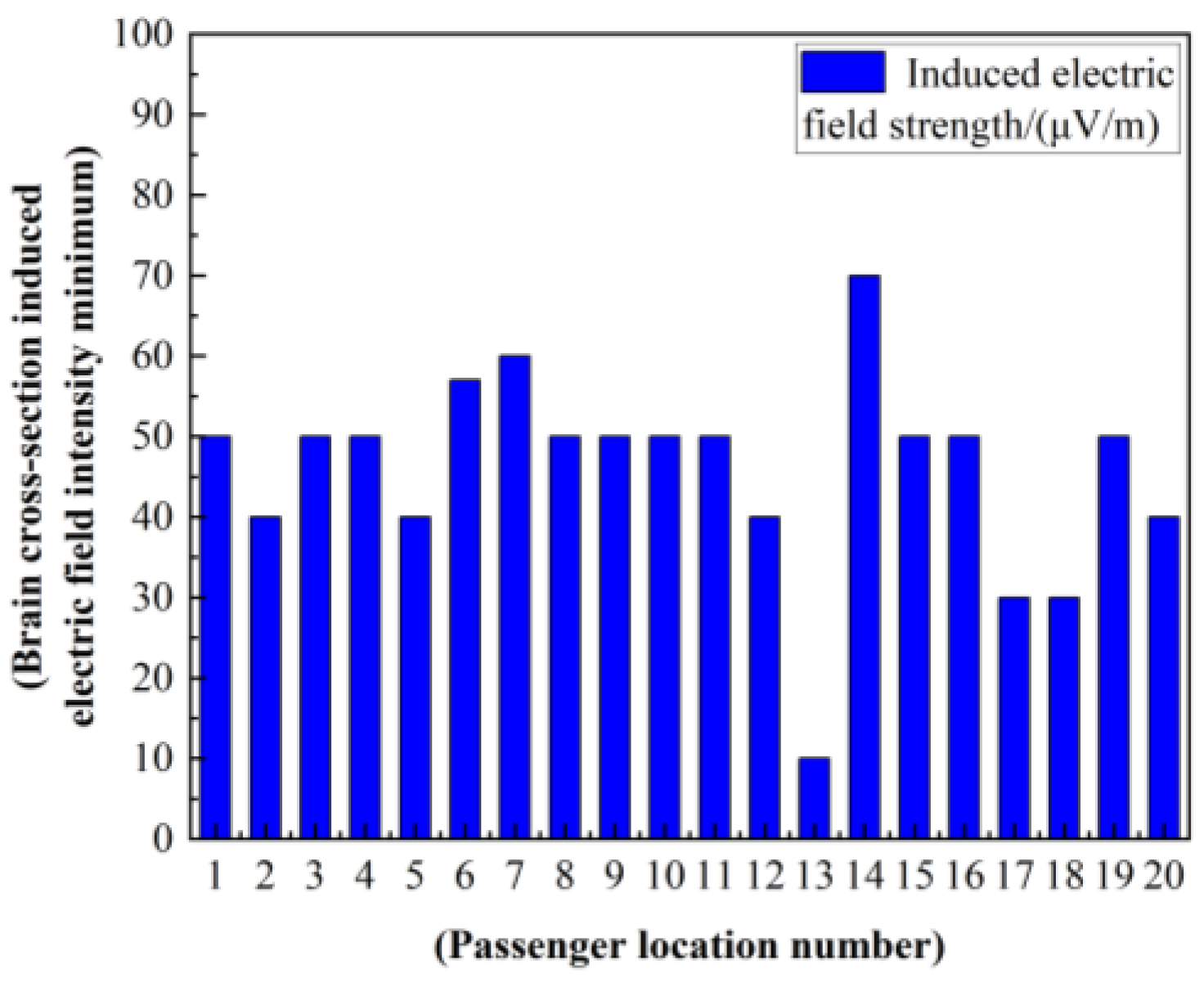
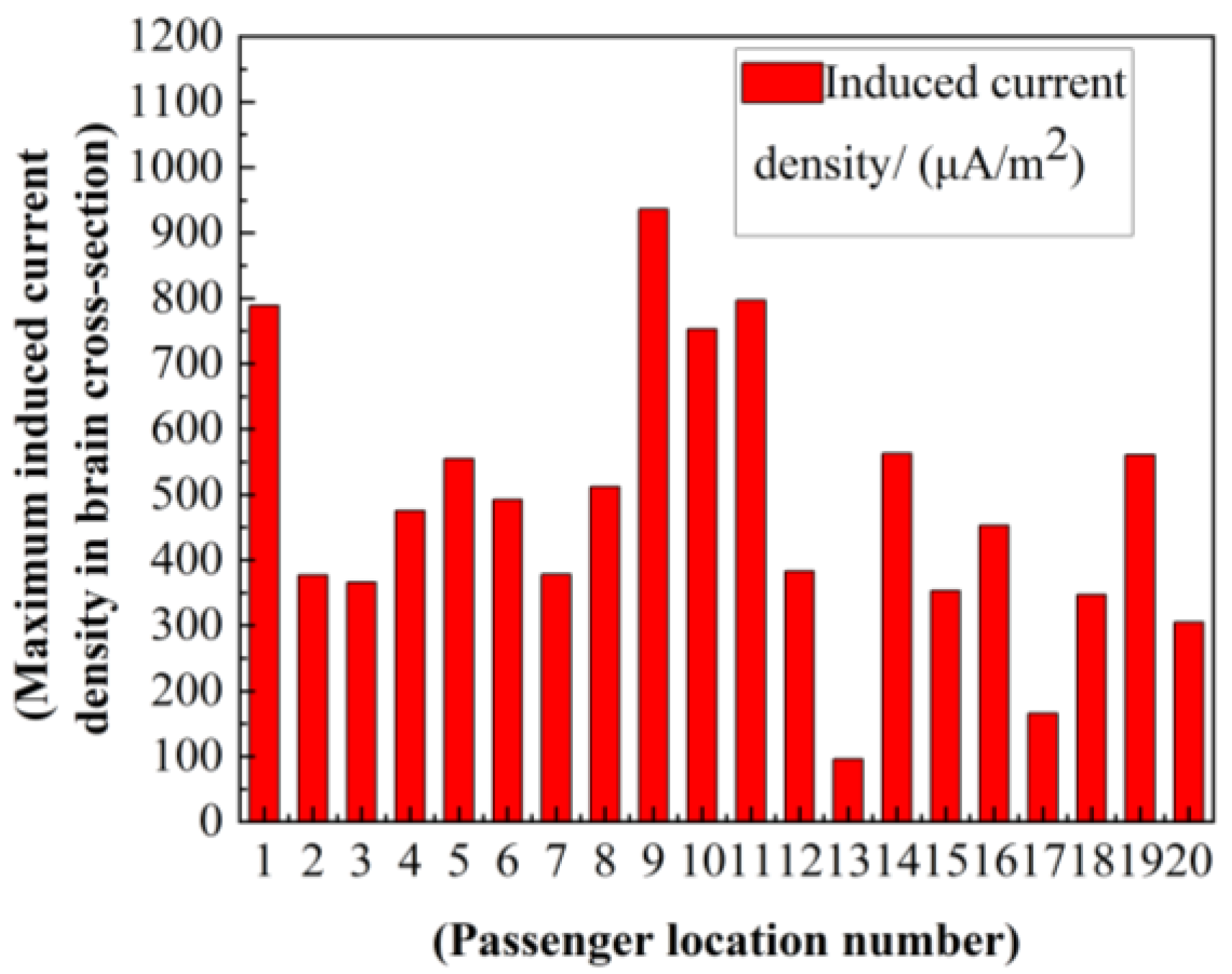
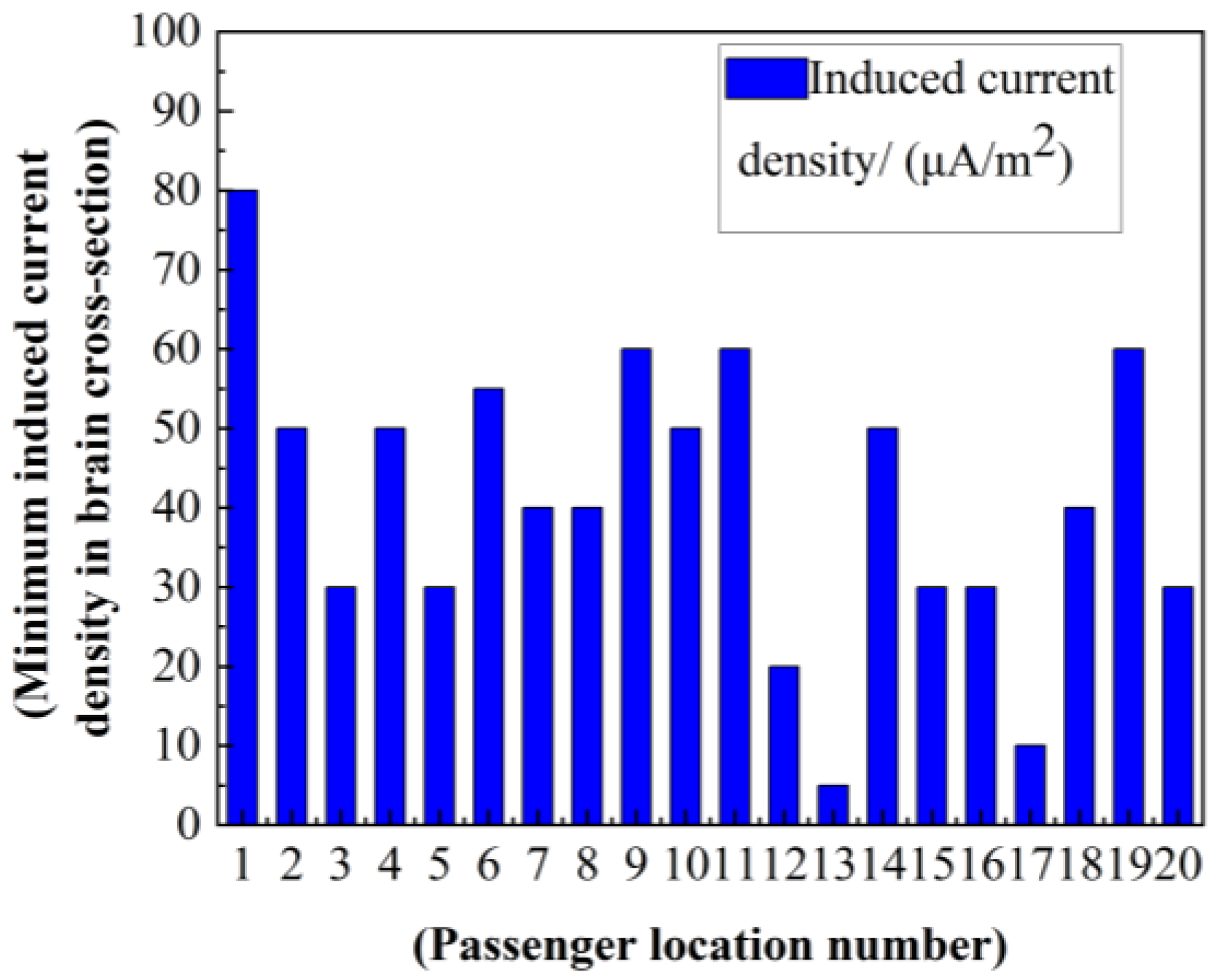

| Parameter | Head Car | Intermediate Car with Pantograph |
|---|---|---|
| Length (m) | 27.2 | 25 |
| Width (m) | 3.36 | 3.36 |
| Height (m) | 4.05 | 4.05 |
| Vehicle spacing (m) | 17.8 | 17.8 |
| Vehicle weight (t) | 12.0 | 11.7 |
| Human Tissue Type | Relative Dielectric Constant | |
|---|---|---|
| Scalp | 51,274 | 0.427190 |
| Skull | 8867.8 | 20.05500 |
| Cerebrospinal fluid | 109 | 2000 |
| Alba | 5,289,800 | 53.274 |
| Ectocinerea | 12,107,000 | 75.258 |
| Cerebrum | 5,798,969.67 | 2128.532 |
| Muscle | 17,719,000 | 233.29 |
| Skeleton | 8867.8 | 200.55 |
| Trunk | 6,400,222.6 | 151.131667 |
| Frequency Range (f) | Electric Field Strength (kV/m) | Magnetic Field Strength (A/m) | Magnetic Field Density (T) |
|---|---|---|---|
| 1–8 Hz | 5 | 3.2 × 104/f 2 | 4 × 10−2/f 2 |
| 8–25 Hz | 5 | 4 × 103/f | 5 × 10−3/f |
| 25–50 Hz | 5 | 1.6 × 102 | 2 × 10−4 |
| 50–400 Hz | 2.5 × 102/f | 1.6 × 102 | 2 × 10−4 |
| 400–3 kHz | 2.5 × 102/f | 6.4 × 104/f | 8 × 10−2/f |
| Exposed Tissue | F (Hz) | Public | Controlled Environment |
|---|---|---|---|
| Electric Field Strength (V/m) | Electric Field Strength (V/m) | ||
| Head | ≤20 | 5.89 × 10−3 | 1.77 × 10−2 |
| Respiratory system | ≤167 | 0.943 | 0.943 |
| Hand, wrist, foot, ankle | ≤3350 | 2.10 | 2.10 |
| Other | ≤3350 | 0.701 | 2.10 |
| Exposed Tissue | Frequency Ranges | Public | Controlled Environment | ||
|---|---|---|---|---|---|
| Head | f (Hz) | B (mT) | H (A/m) | B (mT) | H (A/m) |
| f ≤ 0.153 | 118 | 9.39 × 104 | 353 | 2.81 × 105 | |
| 0.153 < f ≤ 20 | 18.2/f | 1.44 × 104/f | 54.3/f | 4.32 × 104/f | |
| 20 < f ≤ 759 | 0.904 | 719 | 2.71 | 2.16 × 105 | |
| 759 < f ≤ 3000 | 687/f | 5.47 × 105/f | 2060/f | 1.64 × 106/f | |
| Arm, leg | f ≤ 10.7 | 353 | — | 353 | — |
| 10.7 < f ≤ 3000 | 3790/f | — | 3790/f | — | |
| Passenger Number | Maximum Value of Magnetic Fields Induced in the Brain (μT) | Minimum Value of Magnetic Field Induced in the Brain (μT) | Maximum Value of Induced Electric Field in the Brain (μV/m) | Minimum Value of Induced Electric Field in the Brain (μV/m) |
|---|---|---|---|---|
| 1 | 4.59 | 0.06 | 1110 | 50 |
| 2 | 5.27 | 0.06 | 531 | 40 |
| 3 | 3.45 | 0.04 | 515 | 50 |
| 4 | 4.5 | 0.04 | 669 | 50 |
| 5 | 4.56 | 0.06 | 783 | 40 |
| 6 | 4.73 | 0.005 | 694 | 57 |
| 7 | 3.71 | 0.06 | 533 | 60 |
| 8 | 3.59 | 0.07 | 722 | 50 |
| 9 | 4.94 | 0.07 | 680 | 50 |
| 10 | 4.88 | 0.01 | 500 | 50 |
| 11 | 5.59 | 0.02 | 700 | 50 |
| 12 | 3.27 | 0.03 | 540 | 40 |
| 13 | 3.68 | 0.01 | 135 | 10 |
| 14 | 5.02 | 0.02 | 793 | 70 |
| 15 | 3.97 | 0.037 | 498 | 50 |
| 16 | 4.33 | 0.02 | 638 | 50 |
| 17 | 3.31 | 0.02 | 233 | 30 |
| 18 | 2.57 | 0.02 | 490 | 30 |
| 19 | 3.96 | 0.03 | 790 | 50 |
| 20 | 4.16 | 0.02 | 430 | 40 |
| Passenger Location Number | 1 | 2 | 3 | 4 | 5 | 6 | 7 | 8 | 9 | 10 |
|---|---|---|---|---|---|---|---|---|---|---|
| Maximum value of induced magnetic fields in the brain (μT) | 4.59 | 5.27 | 3.45 | 4.5 | 4.56 | 4.73 | 3.71 | 3.59 | 4.94 | 4.88 |
| Minimum value of induced magnetic field in the brain (μT) | 0.06 | 0.06 | 0.04 | 0.04 | 0.06 | 0.005 | 0.06 | 0.07 | 0.07 | 0.01 |
| Maximum value of induced electric field in the brain (μV/m) | 1110 | 531 | 515 | 669 | 783 | 694 | 533 | 722 | 680 | 500 |
| Minimum value of induced electric field in the brain (μV/m) | 50 | 40 | 50 | 50 | 40 | 57 | 60 | 50 | 50 | 50 |
| Passenger Location Number | 11 | 12 | 13 | 14 | 15 | 16 | 17 | 18 | 19 | 20 |
|---|---|---|---|---|---|---|---|---|---|---|
| Maximum values of magnetic fields induced in the brains of passengers (μT) | 5.59 | 3.27 | 3.68 | 5.02 | 3.97 | 4.33 | 3.31 | 2.57 | 3.96 | 4.16 |
| Minimum value of magnetic field induced in the brain of passengers (μT) | 0.02 | 0.03 | 0.01 | 0.02 | 0.037 | 0.02 | 0.02 | 0.02 | 0.03 | 0.02 |
| Maximum value of induced electric field in the brains of passengers (μV/m) | 700 | 540 | 135 | 793 | 498 | 638 | 233 | 490 | 790 | 430 |
| Minimum value of induced electric field in the brains of passengers (μV/m) | 50 | 40 | 10 | 70 | 50 | 50 | 30 | 30 | 50 | 40 |
| Data | Results of This Paper | Results of Previous Studies |
|---|---|---|
| Maximum value of induced magnetic field in the brains of passengers (μT) | 5.59 | 3.63 |
| Minimum value of induced magnetic field in the brains of passengers (μT) | 0.005 | 0.04 |
| Maximum value of induced electric field in the brains of passengers (mV/m) | 1.11 | 3.64 |
| Minimum value of induced electric field in the brains of passengers (mV/m) | 0.001 | 0.00285 |
Disclaimer/Publisher’s Note: The statements, opinions and data contained in all publications are solely those of the individual author(s) and contributor(s) and not of MDPI and/or the editor(s). MDPI and/or the editor(s) disclaim responsibility for any injury to people or property resulting from any ideas, methods, instructions or products referred to in the content. |
© 2024 by the authors. Licensee MDPI, Basel, Switzerland. This article is an open access article distributed under the terms and conditions of the Creative Commons Attribution (CC BY) license (https://creativecommons.org/licenses/by/4.0/).
Share and Cite
Shi, L.; Liang, J.; Liu, Y.; Zhao, Y.; Li, X. Electromagnetic Environment Assessment and Safety Research of Electrified High-Speed Railway Carriages. Electronics 2024, 13, 740. https://doi.org/10.3390/electronics13040740
Shi L, Liang J, Liu Y, Zhao Y, Li X. Electromagnetic Environment Assessment and Safety Research of Electrified High-Speed Railway Carriages. Electronics. 2024; 13(4):740. https://doi.org/10.3390/electronics13040740
Chicago/Turabian StyleShi, Lei, Junyi Liang, Yazhi Liu, Yuanyuan Zhao, and Xinran Li. 2024. "Electromagnetic Environment Assessment and Safety Research of Electrified High-Speed Railway Carriages" Electronics 13, no. 4: 740. https://doi.org/10.3390/electronics13040740
APA StyleShi, L., Liang, J., Liu, Y., Zhao, Y., & Li, X. (2024). Electromagnetic Environment Assessment and Safety Research of Electrified High-Speed Railway Carriages. Electronics, 13(4), 740. https://doi.org/10.3390/electronics13040740





